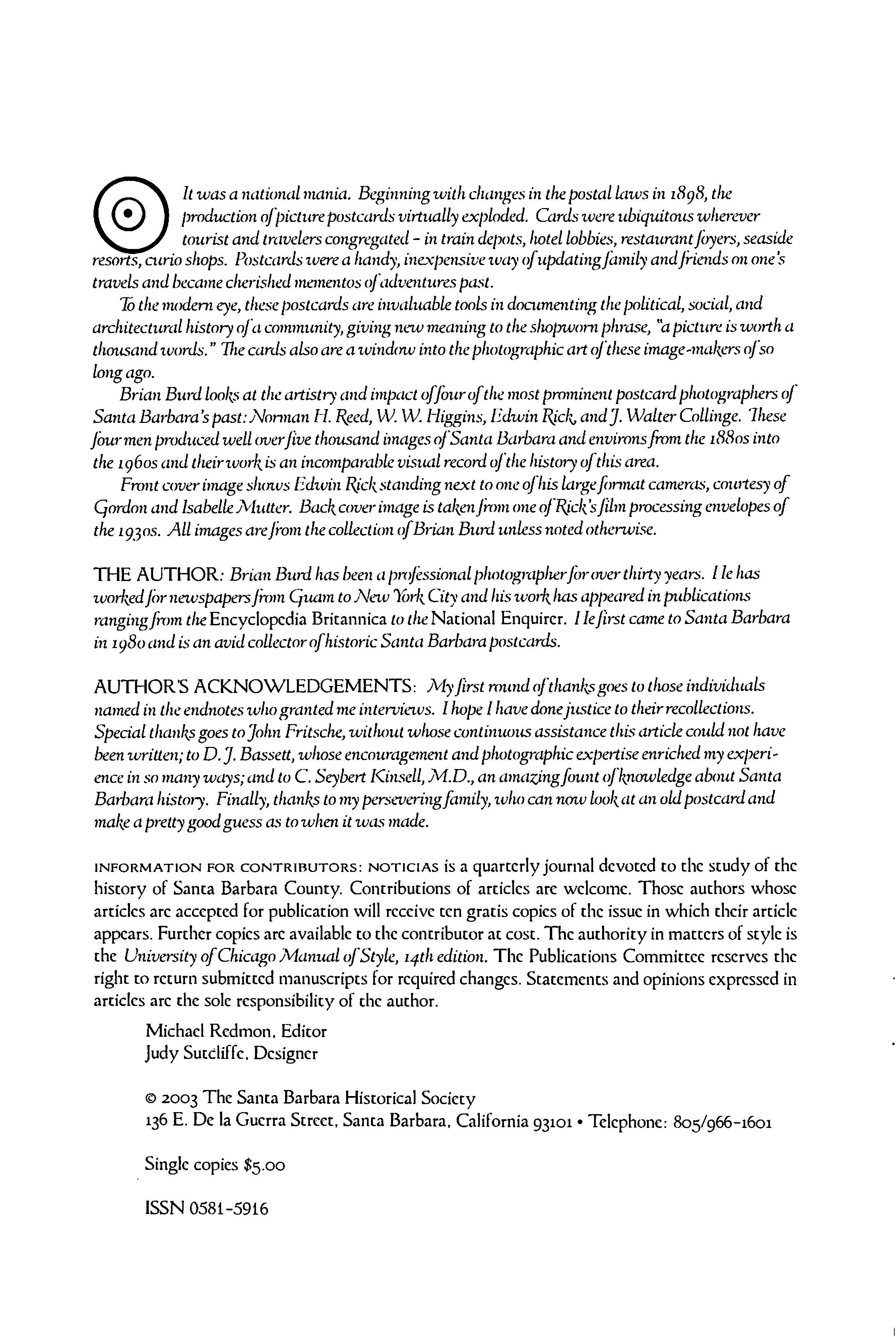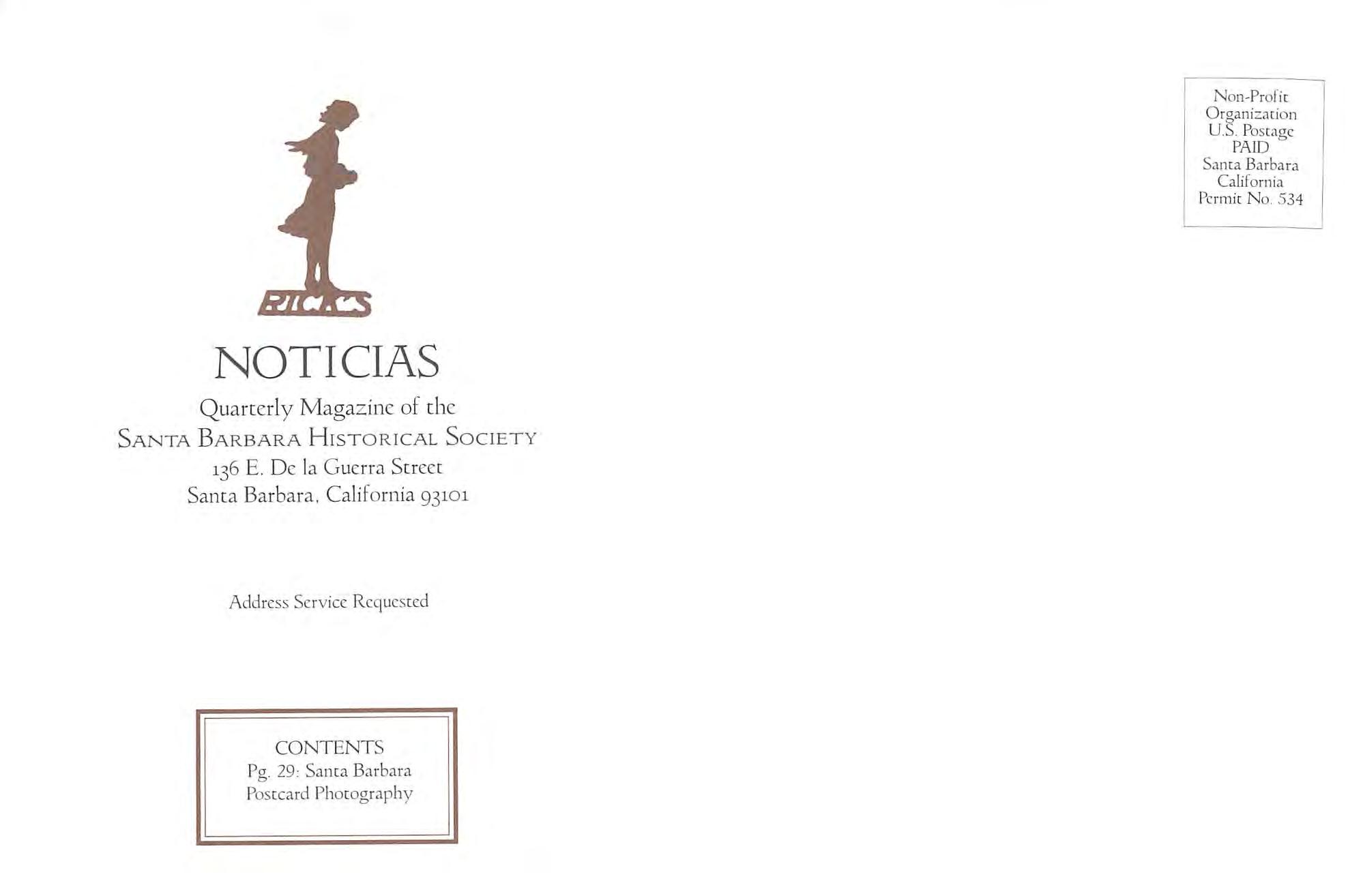3anta Dardara
\^t‘Mn Gut^
Santa Barbara and photography was a match made in paradise. Santa Barbara has always been a popular, even exotic, sub ject for photographers. With galleries ol city views in most photography studios, sporadic exhibitions, and a number of busi nesses selling equipment and supplies. Santa Barbara was a very fertile place for photography. In 1888 the Santa Barbara Dry Plate Company opened on Bath Street selling the relatively new invention of pho tographic dry plates to both amateur and professional photographers. The company advertised that, "We have fitted up a Dark [sic] room at the factory, where everything necessary for development will be found. This room, with developer, is for the free use of amateurs.”'
Over nine hundred photographs were displayed in an 1899 Santa Barbara exhi bition sponsored by the local Amateur Pho tographic Association.^ More than sev enty professional photographers operated in Santa Barbara between 1860 and 1930. In 1915 alone eight professional photogra phers had studios on lower State Street with several others, such as the Gledhills and Miss A. L. Hay. operating on side streets,^
The photographers of Santa Barbara
were popular subjects in local newspapers during the period. 1896-1900. Articles ap peared about an "enterprising photogra pher” building a scaffold and trying to get a picture of the snow-capped mountains behind the mission but having his shot thwarted by low clouds^ the relocation of a small building used by "Rogers the Photographer";^ N. H. Reed winning a photo contest;^ and brief news items about the activities of Reed’s family.
It was significant news when local amateur photographer WB, Clinton of fered his photographic plates for "stereopticon entertainment’’ in 1899 at the Ar mory Hall. Clinton, described as "a Santa Barbara boy, who is now in the Philippines ’ with the U.S. military, had apparently sent back views of army life. Professional Santa Barbara photographer A. H. Rogers was credited with preparing the plates for stereopticon viewing—reported as the first time such a process was performed in Santa Barbara.^ Rogers was a known friend of amateur photographers and offered "free darkroom and chemicals for amateurs.”
Tlic popular status of photography was evidenced by a steady flow of newspaper articles around the turn of the century. An article titled "Injurious Photographic
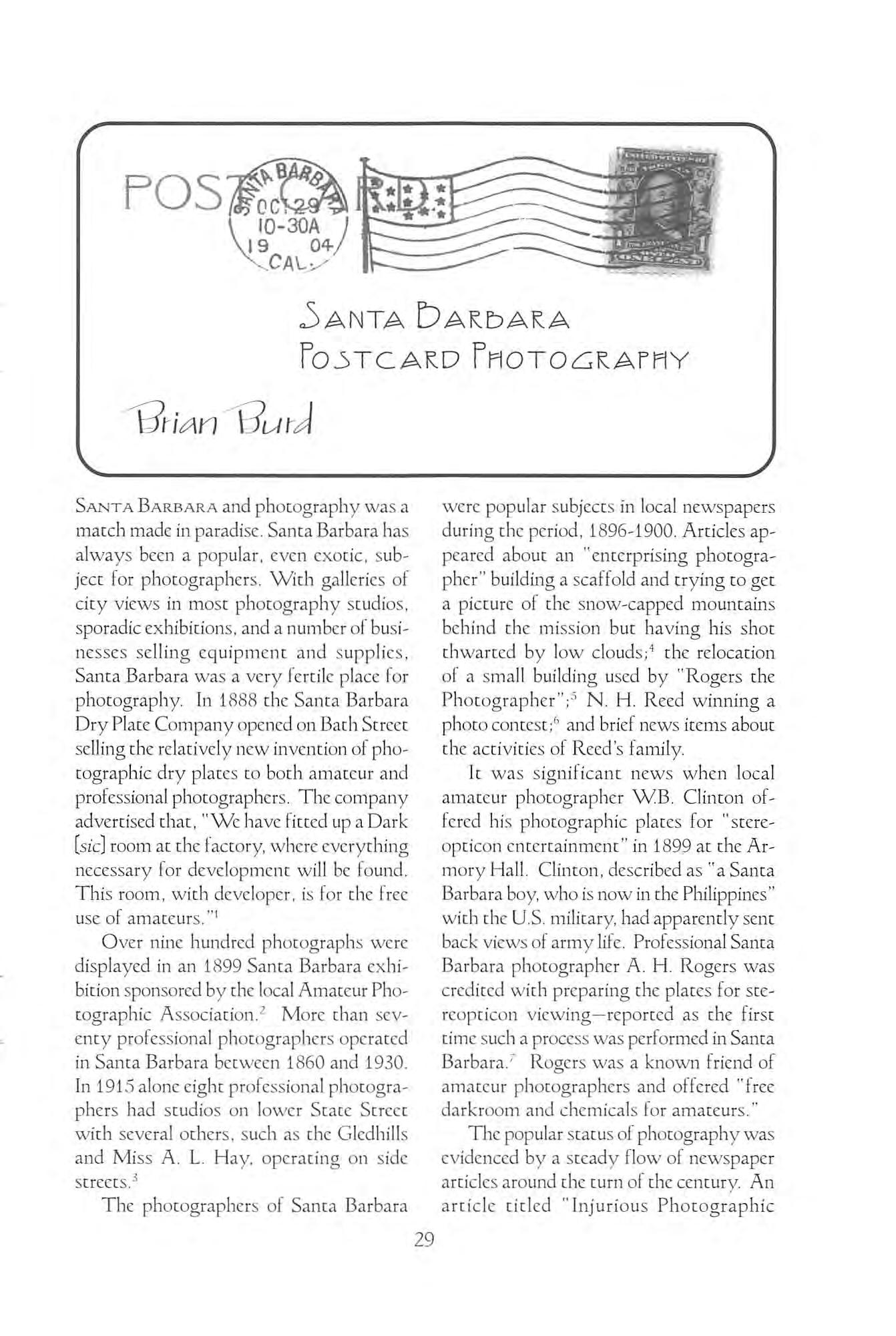
P««r' ●* yi «»
'’03TCARD rhOTO^RARMY
29
Chemicals” was an alarming warning to amateur photographers to be carelul how they handled chemicals.'* A story about a diorama display of picnicking dolls in a wooded glen at the 1892 Floral Festival noted that "a Kodak tiend is pointing his deadly camera” back at the spectators the
Henry Jackson. Jackson was renowned for his spectacular American scenic photographs, which contributed to the forma tion of Yellowstone NationalPark,and for his shots taken during eighteen months of traveling the world photographing various modes of travel.
Jackson arrived in his own rail car out¬ fitted as a rolling exhibit hall scene.^ An ar¬ ticle just a few years later noted that al¬ though amateur photography was not the craze it had once been—"The kodak [sic]
fiend is not so commonly seen as was the case a few years ago"—it was not yet dy ing out like other crazes. A front-page story ecstatically reported a new process that produced ''natural colors” in photo graphs. It quoted Sir Henry Wood,of the London Society of Arts, as saying that even "inferior” pictures would show "col ors with perfect accuracy" when treated with the new process."
One of the most interesting Santa Bar bara photographic stories involved the 1899 visit of famed photographer William
and spent several days parked at the Victoria Street station. Here to take fresh pictures of the mission, the ocean, and general views of the city (he had photographed here several times since 1870),Jackson impressed the public with his spectacular photographic prints and lithographs up to six feet across and books of photos measuring 18x24inches. On one day alone over one hundred people visited the car and F. H.Knight had Jackson’s pho tographs on display and for sale at his store. When someone asked Jackson, who had made his mark photographing the beauty of nature, if he would photograph

NOTICIAS 30
Summerland he replied."No.too many oil derricks and the muss ot traffic, newspaper noted that Jackson was not seeking to sell photographs.
The ”13
LEFf:Postca7'ds can be a vaiuahle record ofa communityseverydaylije. Ihislithographedpostcard,printedin Qerrihmy,depictsthe400block.of StateStreet,ca. ujio.
ous city and coast views of Santa Barbara (iS70'1906).

15
Returnino to Santa Barbara in October of 1900 to get some updated photos Jackson wrote, "Hot ride to S.B., found the Arlington 'full to the limit'. Got room in the old San Marcos.” When he tinally got into the Arlington the next day he la mented, "It is no improvement as far as room is concerned.” After getting settled Jackson went up to the mission and "made two or three views,” but noted that there was,"Very little oi any change in appear ance of place. Jackson made additional trips to Santa Barbara in 1902 and 1906.
Several significant changes in postal laws between 1898 and 1907 triggered a national postcard boom. Prior to 1898 nearly all postcards mailed in the United States were printed by the federal govern ment and sold as blank cards by the Post Office with a stamp imprint on the card. An Act of Congress in 1898 "allowed American publishers to print and sell 'pri vate mailing cards’ at the postage rate of one centeach,”’" and allowed the purchaser of these new cards to purchase a stamp for mailing at the same rate as the govern ment-issued cards. Tliis law restricted the
Hi £ El II B IP b ft ● ■ r [T WiP B s li c’-.n : »» C IMMi - ●● ifi si ' -A' I D..^rr. ■ V' e. A i ■'W.. « 1. W
31 POSTCARD PHOTOGRAPHY
It is difficult to be absolutely certain of die authorship ofsome ofJackson’s vast pro duction over his ninety-nine year life. Early in his career it was not uncommon for pho tographers to trade negatives with one an other, with whoever held a negative claim ing authorship. Yet wedo know specificdates that Jackson was photographing in Santa Barbara and can only surmise that most ot the iniagcs he claims were indeed taken by him. In addition to images ot the Santa Bar bara Mission and friars(1880 and later).Jackson is also credited with photographing at the El Capitan beach area(1880), and variM
BELOW:lliLsimageojthePotterHotel,taken by William HenryJack:>on,waspublishedasapostcatxlin igobbytheDetroitPublishing Company, oneojthelargestpostcardproducers.
message and/or image to one side of the card while the other carried the address and postage. Another regulatory change required the words "Post Card - Carte Postale” to be added at the top of the ad dress side for the cards to meet the re quirements of the international Postal Union and thus be eligible for interna tional mailing.*^ The changes of 1898 also stipulated a maximum size of 3 1/4 inches by 5 inches for privately printed cards, and that the cards’ "weight and quality must be substantially” like gov ernment issued post cards.

20 22
Even moreimportant werecliangesin die 1907 "Postal Bulletin” specifications allow ing the address side of the card to be divided with the addresson the right side of the card and a message on the left side of the card, and the authorization of advertising or illus trations to appear on the back as well as on the message portion of the card.^‘
Santa Barbara photographers jumped at the opportunity to make money by cre ating postcards that both locals and tour ists would want to buy, while local shops sought postcards to sell from both local photographers and from printers. Many ofthe large national and international pub lishers did not reach small American towns,so local businesses frequently sent photographs or negatives to postcard printers, sometimes in Germany, and be came their own publisher.
In 1901 Kodak introduced its Velox
photo paper in the dimension of a post card with a normal light-sensitive emul sion on one side and the other imprinted as the address side of a postcard. Any size negative could be enlarged or reduced in the printing process to fit this paper. To capi talize on the popularityof being able to send one’s picturestofriendsasa postcard,Kodak in 1903introduced the3A lineoffoldingcam erasthat produced negativeson 122film that were 3 1/4 by 5 1/2 inches^ - the dimen sions Congressstipulatedfor the size ofpost cards back in 1898.These negativescould be contact-printedontothe postcard paperstock by simply placing the negative into direct contact with the paper. A shortexposure of light from a gas light or any other control lable source v^thout the use of an enlarger was all that was needed to expose the paper. The exposed paper was then tray-processed in the normal developer/stop bath/fixer se quence of chemicals used in all darkrooms. Anyone with aKodak 3A cameracould have photos of home, family, or travel easily printed into postcards.
Between 1903 and 1943, Kodak pro duced approximately 300,0003A cameras at factories in the United States and Canada. Some of Santa Barbara’s photo processors capitalized on these changes and advertised that they could turn a customer’s negatives into postcards. Pro fessional photographers also used the Kodak 3A cameras and often used the post card photo stock as a default paper in the
32 NOTICIAS
^UTHOP/ZED BY
darkroom. Kodak’s 122 film was manu factured from 1903 until 1971.“
The Kodak 3A cameras came in many variations,some even sporting a high qual ity German Zeiss lens and a coupled rangefinder. While typically of black enamel and black leather, Kodak made some stunning premium models with red leather bellows and red-stained wood lin ing the focusing track. The prices ranged from only $12 for the 1909 3A Folding Brownie to $109.50 for the 1916 3A Au tographic Special model.“ The popular ity of making and sending yourown photo postcards was encouraged by the nation wide Photographic Post Card Exchange club whose members shared their photo postcard views.
sometimes carried a message to the recipi ent stating that the card was bought when the train stopped,that the writer was "on the train,” or when the steamer came to port,and postmarked at the next location. An early postcard ofthe Hotel Nealshows asign at least six feet acrossfacing the train station statingsimply"POSTCARDS. Cards postmarked on trains received a Railroad Post Office cancellation known as an RPO. These cancellationssometimes indicated the route ofthe train,such as"Los Angeles-Santa Barbara-San Jose.”
27 28
In 1899 the Santa Barbara Chamber of Commerce seized on the changing post card laws as a promotional opportunityfor the city and established a"Mountain Drive Illustrating Committee” charged with se lecting a photograph to be turned into a postcard. In an additional boost for the Chamber, Camera Craft, a San Franciscobased magazine for photographers, asked permission to publish the winning entry. Through the spring of 1899 the Chamber struggled to select the best photograph. They eventually chose a photo collage by N. H. Reed mounted "in the most taste fully original manner” on a board. Reed received twenty-five dollars for his win ning entry while WW Higgins was voted a special ten-dollar award for his effort. Reed’s work likely became the black and white postcard titled, "Environs of Santa Barbara California, Mountain Drives.”
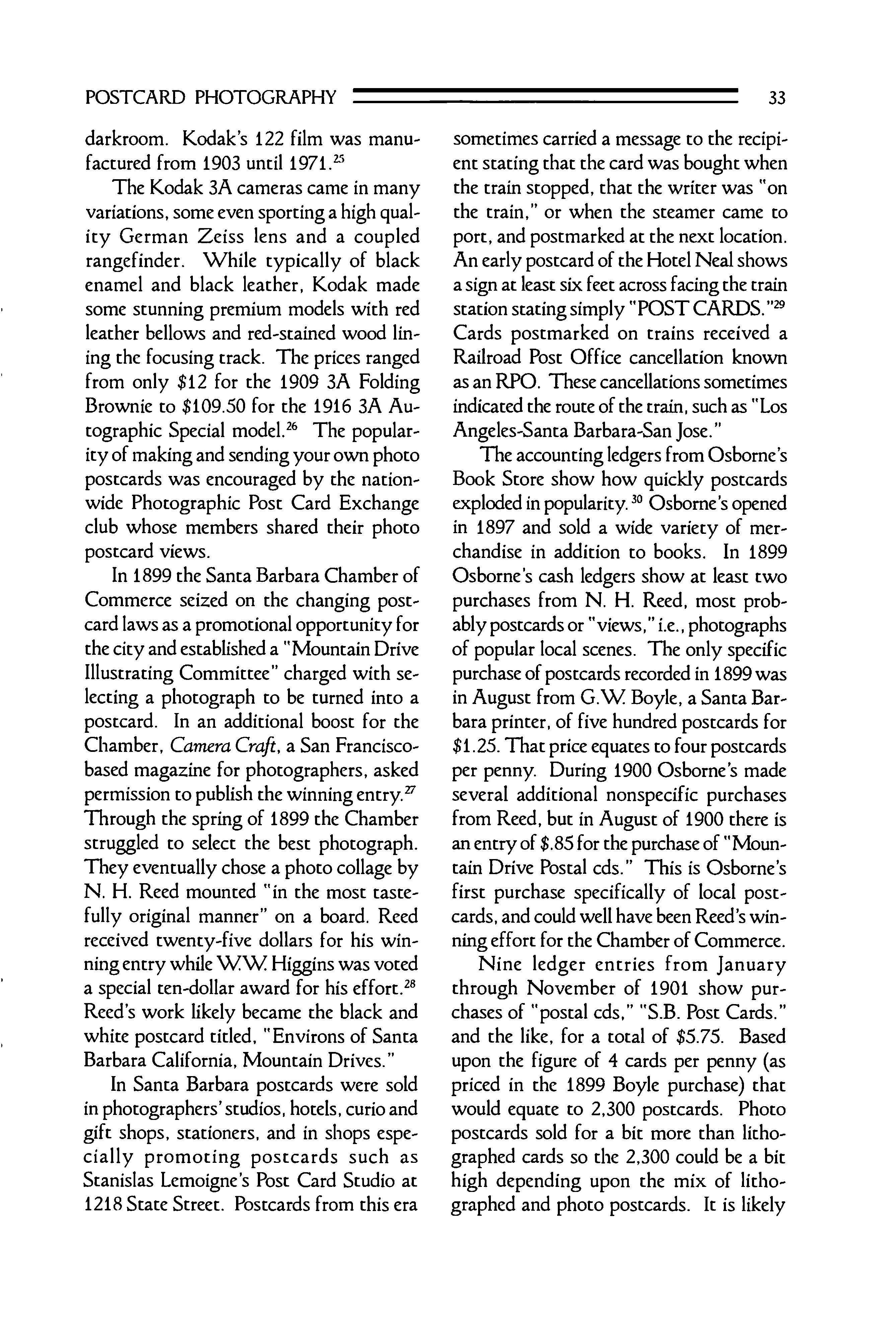
In Santa Barbara postcards were sold in photographers’studios,hotels,curio and gift shops, stationers, and in shops espe cially promoting postcards such as Stanislas Lemoigne’s Post Card Studio at 1218 State Street. Postcards from this era
The accounting ledgersfrom Osborne’s Book Store show how quickly postcards exploded in popularity. Osborne’s opened in 1897 and sold a wide variety of mer chandise in addition to books. In 1899 Osborne’s cash ledgers show at least two purchases from N. H. Reed, most prob ably postcardsor"views,”i.e., photographs of popular local scenes. The only specific purchase of postcards recorded in 1899was in August from G.W Boyle,a Santa Bar bara printer, of five hundred postcards for $1.25.That price equates tofour postcards per penny. During 1900 Osborne’s made several additional nonspecific purchases from Reed,but in August of 1900 there is an entry of$.85for the purchase of"Moun tain Drive Postal cds.” This is Osborne’s first purchase specifically of local post cards,and could well have been Reed’s win ning effort for the Chamber of Commerce.
Nine ledger entries from January through November of 1901 show pur chases of "postal cds,” "S.B. Post Cards.” and the like, for a total of $5.75. Based upon the figure of 4 cards per penny (as priced in the 1899 Boyle purchase) that would equate to 2,300 postcards. Photo postcards sold for a bit more than litho graphed cards so the 2,300 could be a bit high depending upon the mix of litho graphed and photo postcards. It is likely
POSTCARD PHOTOGRAPHY 33
”29
there were additional non-cash purchases ot cards Irom local photographers and from out-ol-town lithographers. This sharp ex pansion in wholesale postcard purchases, with the underlying assumption of in creased retail sales, coincides with the changes in postal laws, the opening of the Potter Hotel and the completion of the rail road to San Francisco.
The accountledgers over the next three years show Osborne’s doing business with N, H. Reed. W W Higgins, giant post card printer M. Rcider, and postcard printer and lithographer Detroit Photo-
sellers to keep up with the demand for post cards, On April 9. 1901. someone named Fred mailed at lease two postcards to a woman in Grand Rapids. Michigan. On one he wrote. "These are the best Santa Barbara postals I could get. The dealers are entirely out. One of them hasjust sent to Detroit for a new supply. The refer ence to Detroit is almost certainly to the Detroit Publishing Company, one of the nation’s largest postcard publishers.
Postcard messages of this era routinely mention collecting cards, buying cards for friends back home, or make reference to
7/iepo\yuldrity ojpostcanh in the early igoos is evidenced by thissign infrontoftheIloteL Neal,ca. njiy. Ihe Mission R^ivaL-style hotel blended nicely xvith the railroad depot,the archesojivhich may beseen atleft.

Hotel Neal. SANTA BARBARA.Cal.
graphic Company. For the next forty years Osborne’s would be one of the most prolific postcard publishers and sellers in Santa Barbara, utilizing the photographs of many local and nationally renowned photographers.
At times it was difficult for postcard
recently sending or receiving cards for a collection. A 1907 Santa Barbara card car ries the unpunctuated message. "We are off for Los Angeles today. Geo got us an album for postcards it is a dandy hold nearly 300 cards about 1908 reads, "Dear Bridgit, Tliese are
An unmailcd card of ”32
NOTICIAS 34
kUKCHROOM 'uaucMioa /ST
■? niT'i
CURCH i!«aR
CARDS
CO help your colicccion. 1 have about 400 in mine.”33 A card mailed in 1905 carries
the inscription."It will give me pleasure to add an occasional card to your S.B. collecA card ol the Potter Hotel dining "34cion, room carries the message. ”1 hope your Aunt Tracey didn’t send you one of these cards when she was here."3-i
Through 1907. Mascot Distributing of Los Angeles was still able to wholesale major name lithographers' postcards one thousand tor three dollars. Their prices included imprinting on the cards advertis ing pitches for local businesses. Mascot’s promotional card was a color postcard of the Santa Barbara Mission with an over print above the mission reading, "Califor nia Scenic Picture Cards... Distribute cards with your advertisement for good of State and your own advantage.
Kodak, relatively few people had cameras so postcards served asinexpensive mcincn-cos and a way to share a trip with others back home. Postcards were also a valu able and inexpensive way of advertising for hotels and businesses. Individuals used photo postcards of their residence, oltcn showing children and the family dog. to inexpensively reassure relatives in ocher states that they were doing fine,or toshow off their circumstances. Communities used postcards to record social and professional groups,sports activities, beach and moun tain scenes, street scenes, and so forth.
Some people of the era also recognized the ability ol a simple postcard to record history. A writer in a library journal in 1910 noted that:
”36
In the early 1900s postcards served a variety ol purposes. Despite the success of
Ihc rural beauty of the Santa Barbara area tvus celebrated m this aivard-winning collage pro duced by N.II. I\eed in 1899. Courtesy ofJohn Fritsche.
1.0-day certain cards may be as nu merous as autumn leaves and in ajeiv months they iviLL he equally hard to Jind[W]e wish to im^:iress upon the authorities ofour public libraries the great desirability of collecting this form oflocal views.^"^
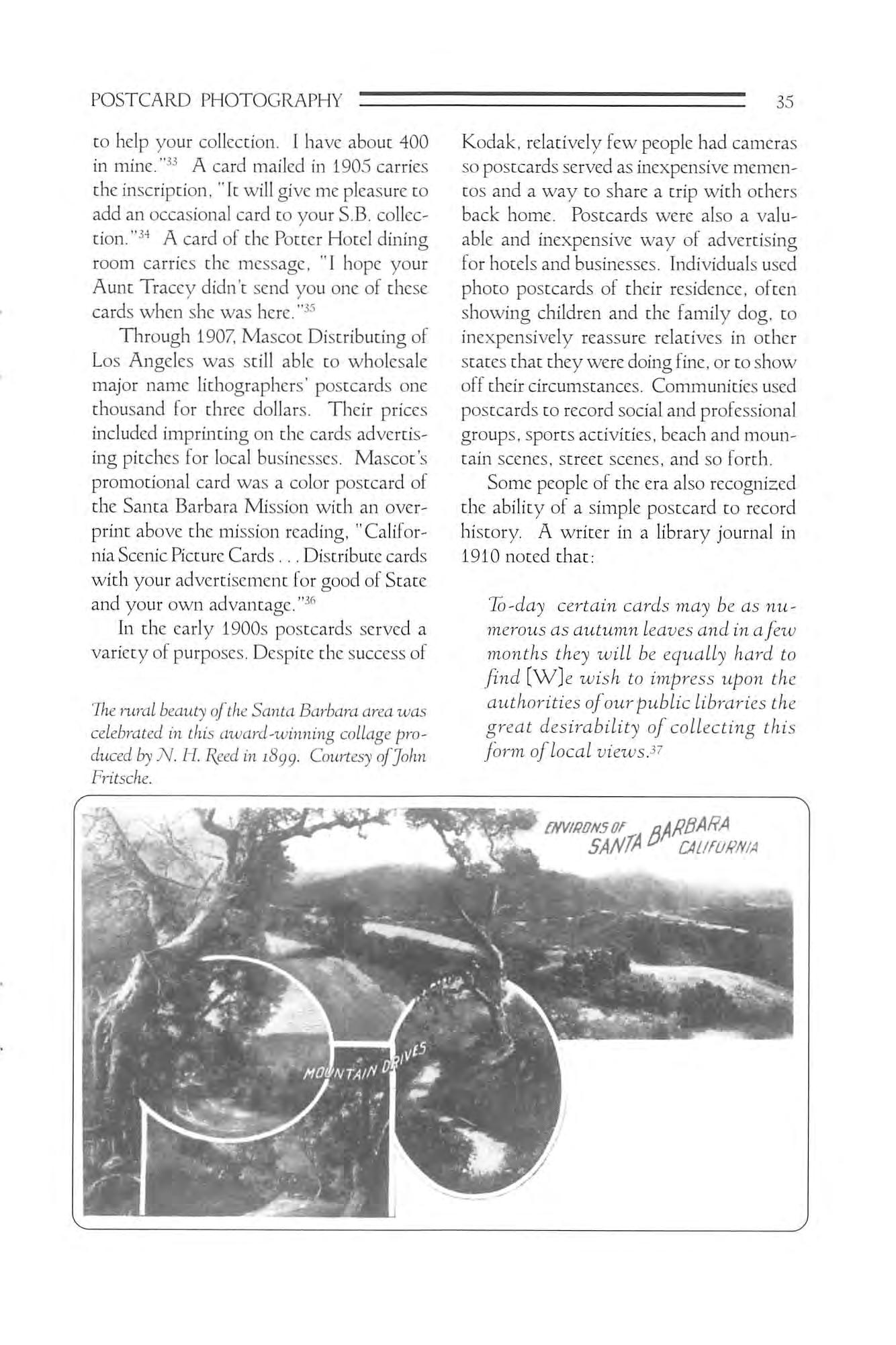
POSTCARD PHOTOGRAPHY 35
There were probably dozens of Santa Barbara photographers who had some oi their work put on postcards, or who took memorable photographs ofSanta Barbara. N.H.Reed,W W Higgins. Edwin Rick, and J. W Collinge arc the principal sub jects of this article because they cower over other photographers in quantity, quality, and duration of their output. Their work spans the period 1888 to the 1960s and in cludes more chan five thousand Santa Bar bara postcard images.
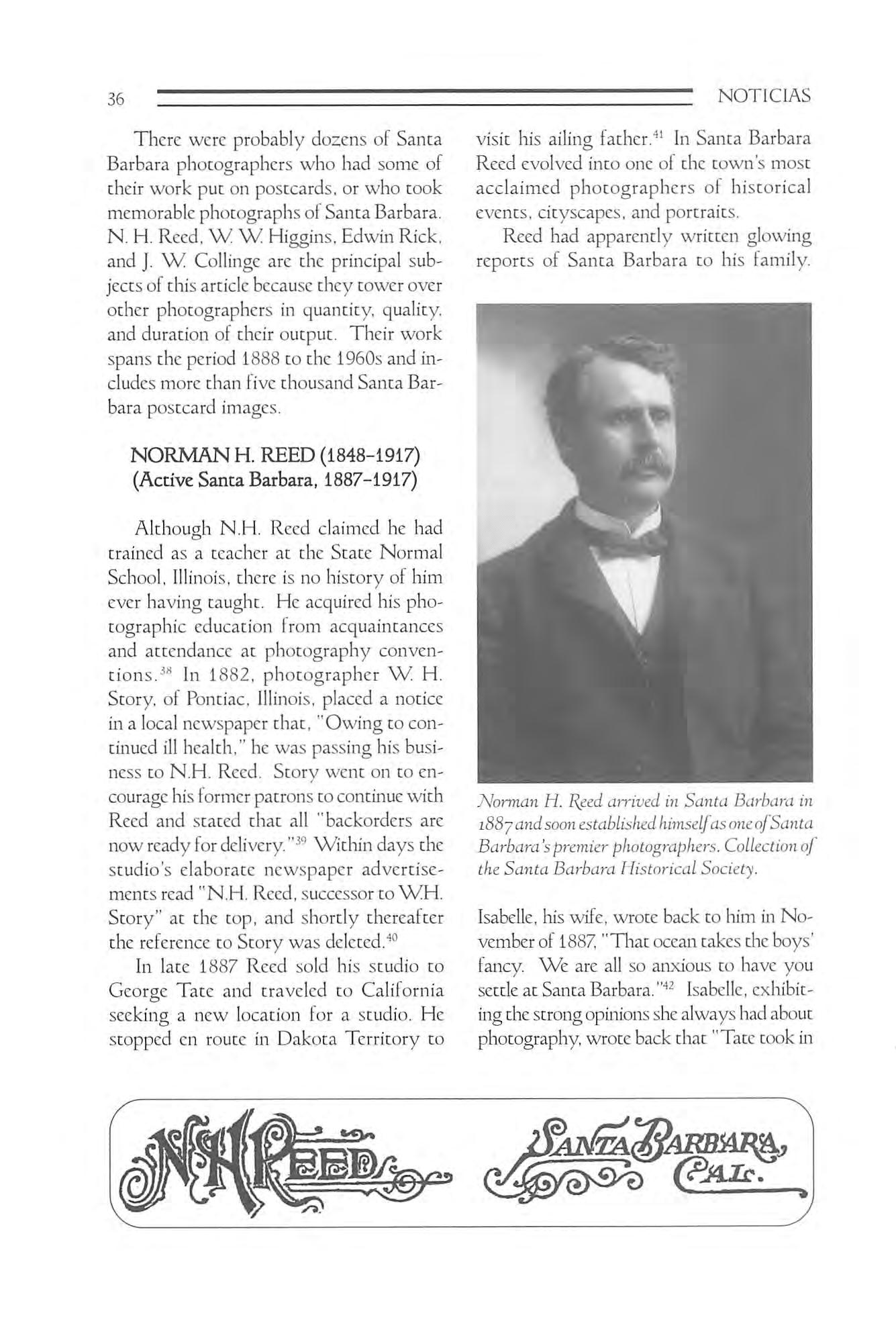
NORMAN H.REED(1848-1917)
(Active Santa Barbara, 1887-1917)
visit his ailing father.'” In Santa Barbara Reed evolved into one of the town’s most acclaimed photographers oi historical events, cityscapes, and portraits. Reed had apparently written glowing reports of Santa Barbara to his family.
40
Although N.H. Reed claimed he had trained as a teacher at the State Normal School, Illinois, there is no history of him ever having caught. He acquired his pho tographic education from acquaintances and attendance at photography convenIn 1882. photographer W H. 38cions. Story, of Pontiac. Illinois, placed a notice in a local newspaper that,"Owing to con tinued ill health." he was passing his busi ness to N.H. Reed. Scorv went on to en¬ courage hisformer patrons to continue with Reed and stated that all "backorders arc now readyfor delivery. Within days the studio's elaborate newspaper advertise ments read "N.H.Reed,successor to WH. Story" at the top, and shortly thereafter the reference to Story was deleted.
In lace 1887 Reed sold his studio to George Tate and traveled to California seeking a new location tor a studio. He stopped cn route in Dakota Territory to
Isabelle, his v/ife. wrote back to him in No vember of 1887,"Tliat ocean cakes the boys' fancy. We arc all so anxious to have you settle at Santa Barbara. Isabelle, exhibit ing thestrong opinions she always had about photography,wrote back chat"Tate took in
NOTICIAS 36
Norman H. Reed ajTived in Santa Barbara in i88yandsoon establisfi^d himselfasoneojSanta Barbara'spremier photographers.CnllectionoJ the Santa Barbara Historical Society.
abouc $208 die past month. (I think his pic tures arc rather sick looking). Isabelle con tinued to voice her opinions on photography tor the rest of Reed’s life.
In October of 1888 Isabelle wrote to Norman that the family is "anxious to get a letter from Santa Barbara.” but it is not clear it the family had still not moved west or it Isabelle and some of the children had gone east tor a vacation. We do know, however, that shortly after arriving Reed purchased the studio and gallery of I. N. Cook,who was lauded in 1889 as not only a good photographer, but "the very best in the state. In the purchase ot the stu dio Reed also acquired Cook’s extensive stock of negatives of the Santa Barbara area, including views of the Channel Is lands. attractive local houses,and portraits ol political and business leaders. By 1890 Reed was attaching his copyright to new
photographs that would become Santa Bar bara classics.*’*’
Tlic 1892Floral Festival presented Reed with an interesting professional competi tion. Reed and veteran Santa Barbara pho tographer W J. Rea went head-to-head in advertising their photographic services to the festival participants. Rea placed a long notice in the papers in the weeks preced ing and during the festival stating that he "wishes to make pictures of all the carriages taking part in the Floral procession,"'’' and he requested procession participants to come to his studio for pictures. He even made a point of telling readers that he had "secured for the purpose a fine instrument —a lightning striker.’’*’'’ a flash bar using exploding powder illumination.
Rea sweetened his offer with a gratis print to any costumed participant who came to his State Street studio.*’^ Reed
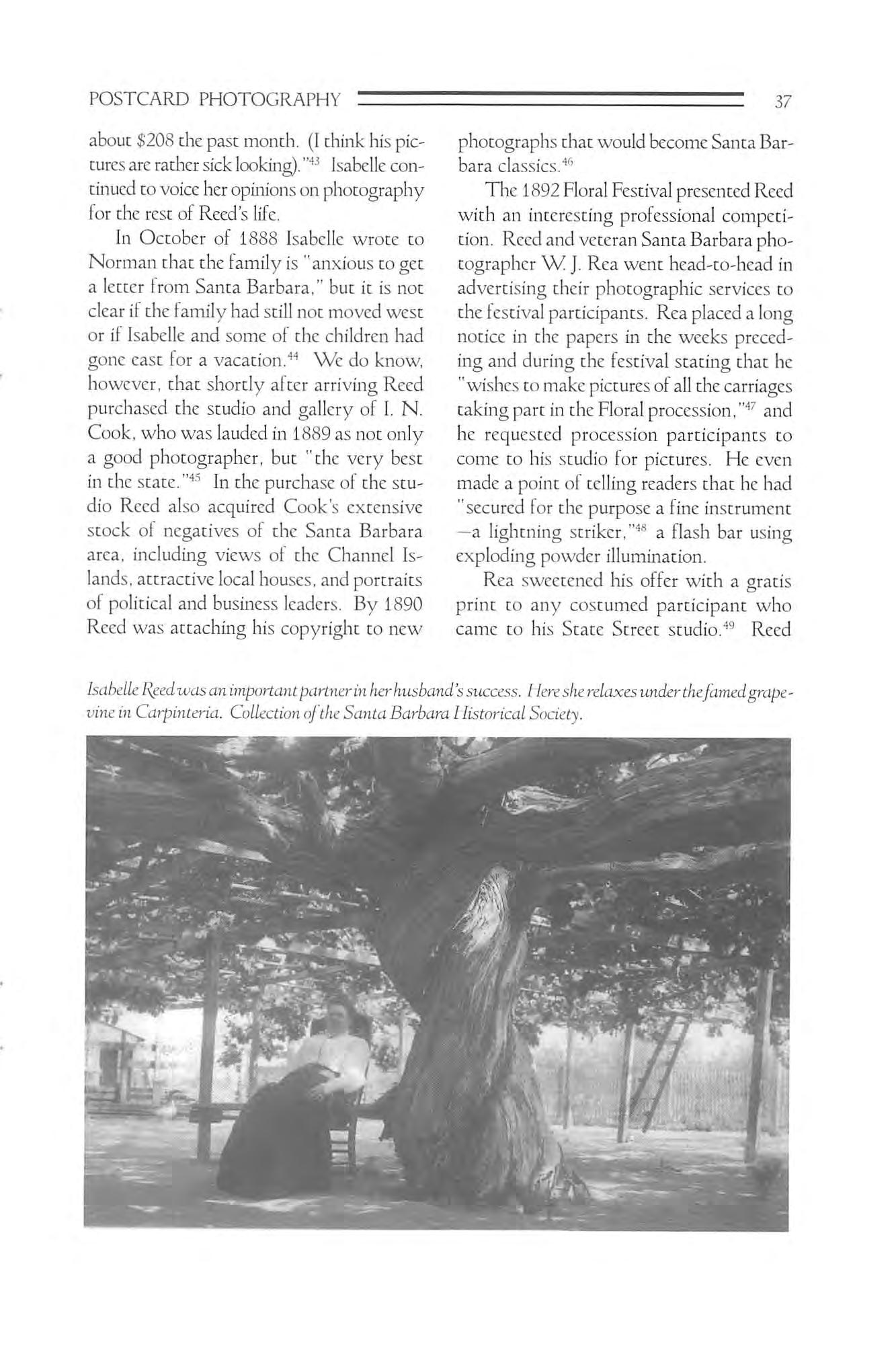
POSTCARD PHOTOGRAPHY 37
4^' * A
Isabellel^eedwasanimpoitcintpartnerin hcrlnoiband’ssuccess. IlereshereUixesunderthefamedgrape vinein Carpinteria. Collection oftheSantaBarbaraIlistorical Society.
aggressively photographed the festivities and ran a single sentence immediately be low Rea’s two paragraphs stating that he had employed five photographers to shoot the Floral Carnival Procession. The impli cation is that Reed sent his crews to the event rather than waiting for the partici pants to come to him. Reed also noted that he had secured two hundred negatives of the Floral Carnival Procession.^® As generous as Rea’s offer ofa free print might have been, it would have been most un likely that dozens of decorated carriages, wagons, bicycle teams, and the hundreds ofindividuals taking part would have been able to line up at his State Street studio to await a photograph.
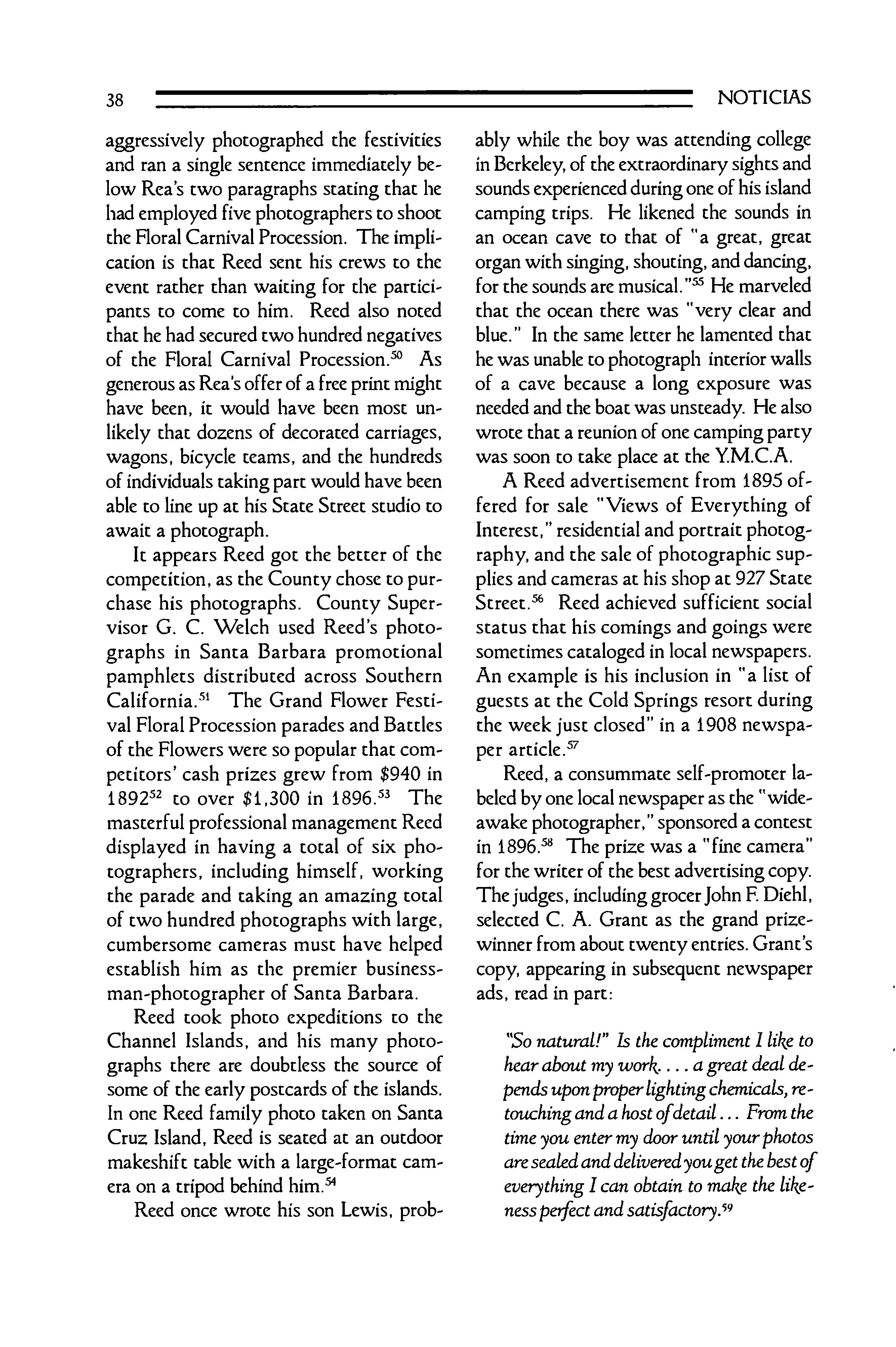
It appears Reed got the better of the competition,as the County chose to pur chase his photographs. County Super visor G. C. Welch used Reed’s photo graphs in Santa Barbara promotional pamphlets distributed across Southern California.^* The Grand Flower Festi val Floral Procession parades and Battles of the Flowers were so popular that com petitors’ cash prizes grew from $940 in 1892^2 ^^ 300 in 1896.^^ The masterful professional managementReed displayed in having a total of six pho tographers, including himself, working the parade and taking an amazing total of two hundred photographs with large, cumbersome cameras must have helped establish him as the premier business man-photographer of Santa Barbara.
ably while the boy was attending college in Berkeley,ofthe extraordinary sights and soundsexperienced during one of hisisland camping trips. He likened the sounds in an ocean cave to that of "a great, great organ with singing,shouting,and dancing, for the sounds are musical.”^ He marveled that the ocean there was "very clear and blue.” In the same letter he lamented that he was unable to photograph interior walls of a cave because a long exposure was needed and the boat was unsteady. He also wrote that a reunion ofone camping party was soon to take place at the Y.M.C.A. A Reed advertisement from 1895 offered for sale "Views of Everything of Interest,” residential and portrait photog raphy,and the sale of photographic sup plies and cameras at his shop at 927State Street.^® Reed achieved sufficient social status that his comings and goings were sometimes cataloged in local newspapers. An example is his inclusion in "a list of guests at the Cold Springs resort during the week just closed" in a 1908 newspa per article.'**^
Reed,a consummate self-promoter la beled by one local newspaper as the"wide awake photographer,”sponsored a contest in 1896.^* The prize was a "fine camera” for the writer of the best advertising copy. Thejudges,includinggrocerJohn F.Diehl, selected C. A. Grant as the grand prize winnerfrom about twenty entries.Grant’s copy, appearing in subsequent newspaper ads, read in part;
Reed took photo expeditions to the Channel Islands, and his many photo graphs there are doubtless the source of some of the early postcards of the islands. In one Reed family photo taken on Santa Cruz Island, Reed is seated at an outdoor makeshift table with a large-format cam era on a tripod behind him.
54
Reed once wrote his son Lewis, prob-
"5o natural!” Is the compliment 1 like to hearabout my work, ■ ■ - great dealde pendsupon properlightingchemicals,re touchinganda hostofdetail... From the time you enter my door until yourphotos aresealedand delivered ycmgetthe bestof everything 1can obtain to make the like nessperfectand satisfactory. 59
NOTICIAS 38
In 1890 Rccd posed two friars in the garden area that once existed west ol the mission and later sold black and white photo postcards of the scene. Various color lithographic publishers re-used the image for decades, but with bizarre al terations: sometimes the friars appear in lush gardens, sometimes in desolate lots; trees appear and disappear around the Mission;fences appear,disappear, or arc transformed into a thick hedge; and sometimes heavy clouds pile above the mission while at other times the sky is clear. In one version the mountains arc snow-capped. The only constants arc the two friars haplessly stuck like card board cutouts in the garden for forty years and the mission itself. Probably no single Santa Barbara photograph had the postcard endurance of this shot. Post marked cards of this image, in various permutations, range from 1898 to 1944. It was likely this image that was de¬
scribed in Reed’s 1917 obituary.*^’ It told how Reed,labeled as the "well known pio neer photographer”,had once built a giant scaffold near Los Olivos street and photo graphed the Mission from considerable el evation. The obituary writer pointed out thatsuch a photograph was no longer pos sible as the trees, presumably in the fore ground, had grown too large.
Another Rccd image that had staying power was his shot of a heavyset hunched friar standing behind the mission near a large sycamore tree titled, appropriately enough,"Under the Sycamore Tree.” Reed copyrighted the image in 1893, but it ap peared several ways. While it may origi nally have been a black and white photo postcard, by 1907 it was a lithographed color postcard. By 1913 the image was transformed into an ornate color card chat featured a Christmas greeting on cop and embossed poinscccias and brass Christmas bells on the bottom. Like ocher photogra7/ie
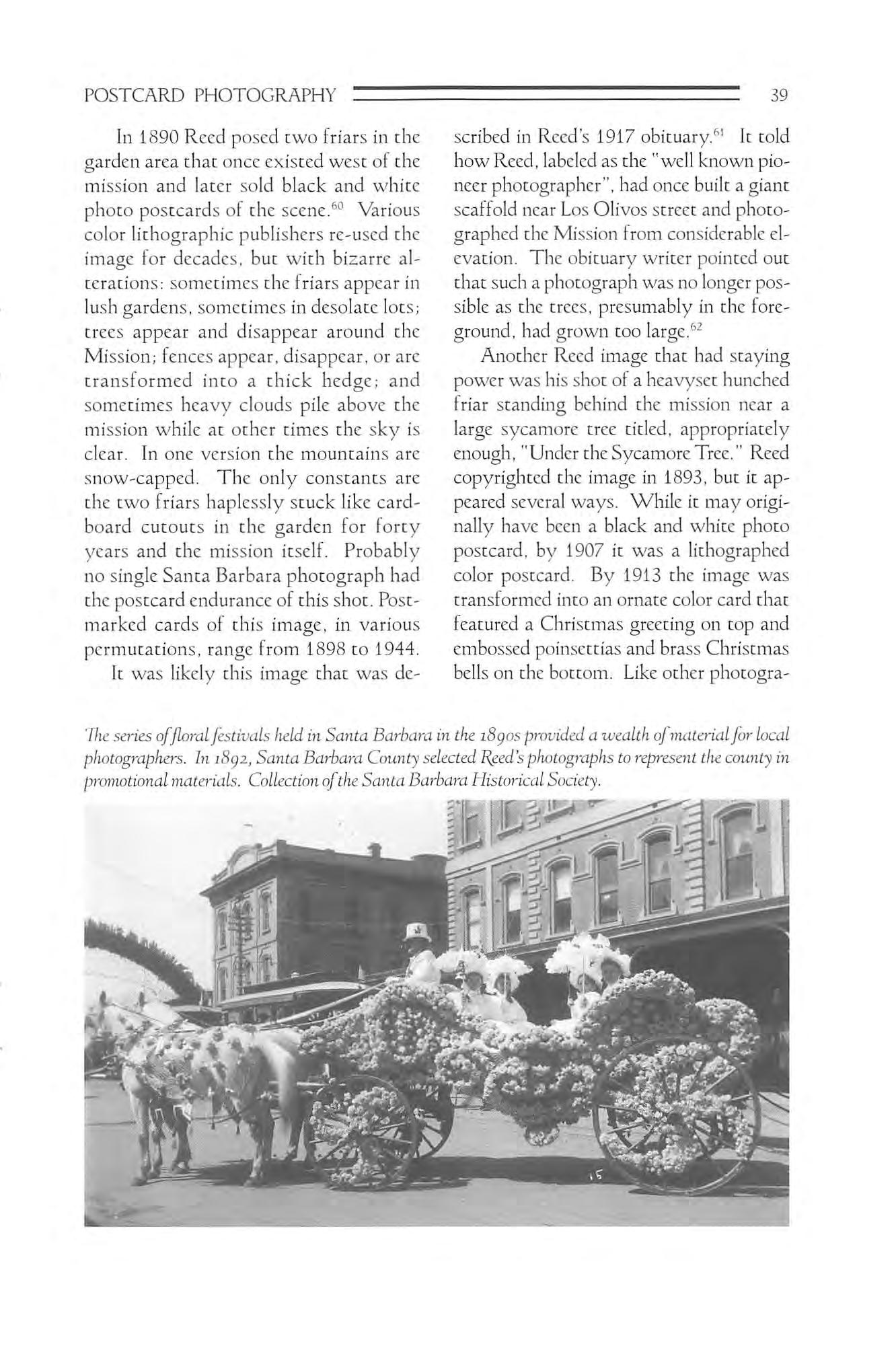
POSTCARD PHOTOGRAPHY 39
y V X
series offloralfestivals held in Santa Barbara in the iSgos provided a wealth ofmaterialfor local photographers. In iSgi,SantaBarbara Countyselected Freed’sphotographsto represent thecounty in promotional materials. Collection oftheSantaBarbaraHistoricalSociety.
phcrs,Reed extensively photographed mis sion scenes, including a group picture of the friars in 1901 that was published by Adolph Seligc Company,St. Louis.
Reed turned many of his photographs of the mission into postcards. A report to the California Library Association in 1910 on the types ol visual media available for library acquisition stated that Reed offered

buggy drawn by their horse. Dumpling, was turned into a lithographed postcard titled "Red Rock Cut. Mountain Drive, Santa Barbara, Cal.” In the original pho tograph Reed located the view at "San Marcos Pass.”'’*' Although the photograph was taken around 1900. the lithographed card continued in circulation at least through 1909. Other postcards by Reed
feed’sclassicphotograph oftheSanta Barbara yMission ivds repn)d^iced ccnmtlesstimesin ape riod spanning almostfifty years. Ihis version waspublished by Westam Publishing Company of LosAngeles,ca.igio.
"about 200 views” of the Santa Barbara Mission on photograph postcards.
63
Reed took countless pictures of his chil dren.Fannie.Lewis,and Winfield(Norman W)and often used family members in photos that were turned into postcards. Reed’s photography of the outdoors often had a flowing lyricism,especially reflected in photographs of his children, that set his work apart from the stiffer styles of some of his contemporaries.
A photograph of his wife, Isabelle, taken from behind while she sat in their
showing a single woman sitting in a buggy, with a title referring to a "lake view” or "Mountain Drive,"clearly show Isabelle.
It may have been on buggy rides with Isabelle that Reed started photograph ing the Spanish moss-covered oaks along "Mission Drive,” a name given to a num ber of roadways in the area. These pic tures grew into an extensive scries of color lithographed cards published under his own name. Reed worked extensively with the Adolph Selige Company, St Louis, Missouri. Some of these cards
NOTICIAS 40
65
bear both Reed’s and Selige’s names. Some list only Selige while others list only Reed as the publisher but still carry Selige’s logo, a sailboat with an "S” emblazoned on the sail beside Reed’s name.
There is no doubt that the Reed family members were active partners in viewing, mailing, posing in and enjoying photo graphs,and operating the business. While on vacation in 1892, Isabelle wrote Reed, "You do not mention gallery affairs so sup pose everything is prosperous.’’®^ It ap pears Fannie may have handled some of Reed’s business in the Berkeley area while attending college. In January 1898, Reed wrote her, "I thought that I would not bother you to colect[sic]for the views sold but will if they do not send[payment]by next mo.’’®^ Even friends felt free to offer suggestions about the business. Caroline Gleason wrote to friend Fannie(1899)that since both Fannie and Lewis were going to school at Berkeley. "Won’t your mother move up there now? Wouldn’t it be nice if your father could open up there too and all live up there until you were through college? Hasn’t he enough of a trade there to try it?’’®® There is no record of Reed ever opening another studio after opening in Santa Barbara.
In 1901 Gleason, living in Lansing, Michigan, wrote Fannie that Isabelle "has sent me so many beautiful pictures of Cal. Scenery.’’®^ Fannie herself sent photo post cards to friends and once gave a friend an undated photo postcard with the inscrip tion "Thisis a picture ofthe maypole dance given the last ofschool. It is the only card
I could find. ’70
Again on vacation in 1904, Isabelle utilizes her business sense to write Reed that,"There are some good Kodaks in the crowd here but no one is develop ing. Isabelle had formalized her role in Reed’s business when,in 1899,she became the "Publisher” of his "Santa Barbara
Scenes and Scenery,” a catalogue and de scription of views Reed offered for sale.
In June 1912,Isabelle visited the Grand Canyon as one stop on a long vacation. She wrote her husband that she had pur chased a photo from a photographer there and had mailed it home, writing, "Please frame my picture and hang it up some where in the house. Do not let anything happen to it. for I cannot get another. Reed was apparently not thrilled by his wife sending him a photograph and must have written that he had "misplaced” it, because in July Isabelle wrote:
"72
1certainly shall be mad at you ifyou Lose that photo ofthe Qrand Canon [sic]for wedid not buyasinglepost-card norany souvenirs so 1 could spare the money to buy a photograph 1thought it would please you to see it so sent it home.Now you hustle around andfind it.73
We can only trust that by the time Isabelle returned home that the picture was hung in a prominent location.
A subject Reed returned to many times over the years was roses. Writers had for years written glowingly ofSanta Barbara’s extraordinary array offlora,and especially of her roses. Frank Harrison Gassaway, writing under the nom deplume of Derrick Dodd, recounted in 1882 attending a re cent County Flower and Citrus Exhibition and finding that.
Epses,in particular, were represented in every variety and branch of flora’s loveliestfamily, however rare, delicateorremote—from the Qigantiucus something-or-other to the tiny little "Peruvian Midget,”a variety so small thatfiftyofthem makpa bouquetnolarger than a ten-cent piece,aflowerfitfor the buttonholeofThe Fairy King Himself.^'*
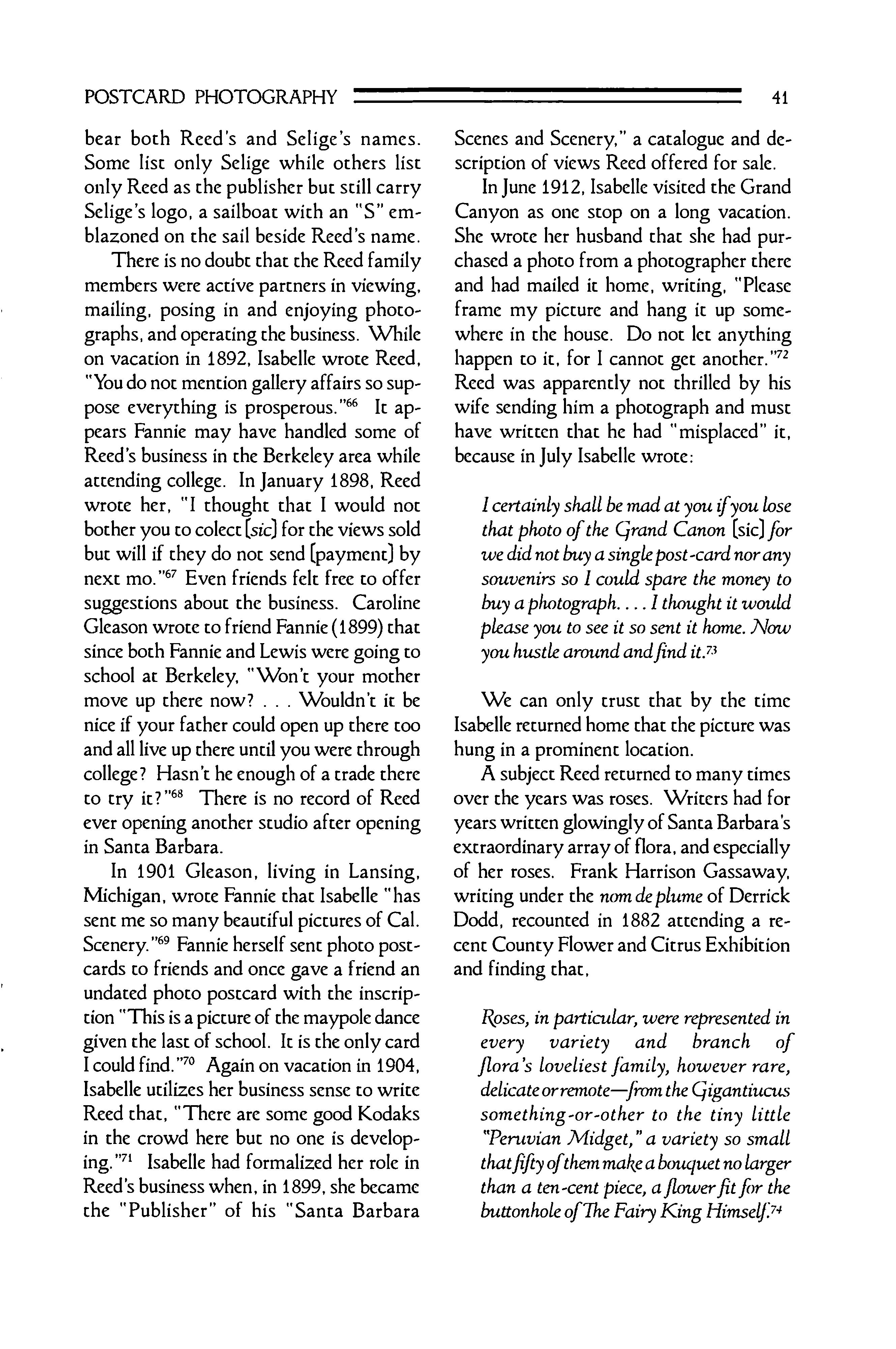
POSTCARD PHOTOGRAPHY 41
Roses were also featured prominently in the Battle ot Flowers parade report in an 1896 newspaper article titled. "Reign of The Rose.” It noted chat roses were extensively used on the floats with pink roses used in canopies, horses' harnesses bedecked with roses of various hues,"garlands ol La France roses." and decorations of "pink Duchessc" roses. Tlie reading population of Santa Bar bara was apparently well-versed in the col ors of varieties of roses as references were sometimes made to rose variety with no mention of color.^'*’
Reed took pictures of many fine rose bush specimens around Santa Barbara, in cluding those around the first Arlington Hotel. Among his Arlington Hotel pho tographs was an 1895 image titled, "La Marque Rose Vine," which was later turned into a postcard, "California’s larg¬
est Rose Bush.” This card features Louise Wliicney at the cop of the ladder, Gladys Ogilvy on the lower rungs of the ladder, and young Arthur Ogilvy standing on the ground. The bush was destroyed when the first Arlington burned down in 1909. Reed also produced the negative of a girl leaningfrom the cop of a ladder into a large rose bush chat was used in the lithographed postcard titled "Child Picking Rose."
A lovely black and white photo post card by Reed showing a daytime view from sea of the Potter Hotel,with two sail boats in the foreground, also became a popular lithographed color card. In the lithographed version, however, the "magic” of creative lithography trans forms the original scene into a romantic nighttime view with the moon siccing im probably low above an enchancingly
Ihc dnmutic landscafye ojthe ChannelIslands frnitjulgroundforphotographers. I{eed pho~ tographed Cueva Valdez on Santa Cruz Island’s north shore, ca. 1895. Collection 0}the Santa Barbara /listorical Society.
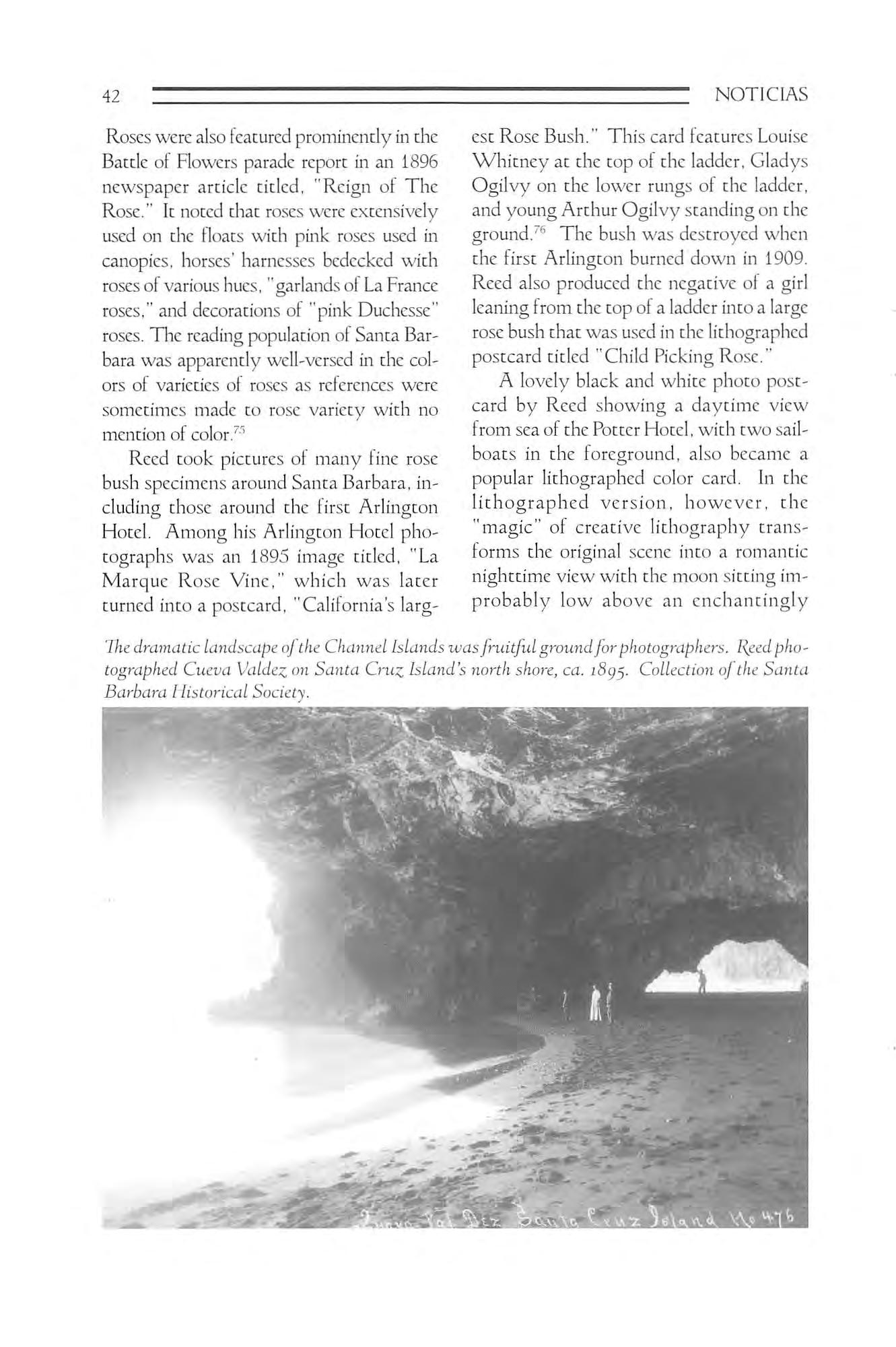
NOTICIAS 42
1 '^
lighccd Pocccr as moonlighc rcllcccs across the water between the two sailboats."Tlic Potter Hotel at Night,from the Bay.Santa Barbara, Cal..” The Benham Company of Los Angeles.^
Yet another ubiquitous card of Reed’s started out as his black and white photo card titled. "High Tide at Santa Barbara,” showing a large wave splashing in Iront ot a bench set along the.seawall at the turn of the century It became a color-lithographed card in both regular size and double size, not credited to him,by The Benham Com pany. sometime alter 1907
W. W. HIGGINS (1856-1930)
(Active Santa Barbara, ca. 1897-1930)
Reed died unexpectedly of complica tions tollowing surgery at Cottage Hospi tal. A local newspaper noted, "Well Known Business Man Dies."and observed. "Many at Funeral oi Norman H, Reed.” then listed the prominent members of the community acting as pallbearers.^^ The Reed family maintained the business for a lew years iollowing his death.
On the back ot one Reed’s photo post cards. circa 1910, is a printed note that he offered "Over eight hundred subjects from which to select." It is unknown exactly how many different commercial postcard images Reed produced over his prolific thirty-year Santa Barbara career.
7H '■ HO
An indication ot Santa Barbara’s appre ciation tor Reed’s work was in the closing line trom his obituary in the MorningPj-ess. Reed’s photographs, it was noted, "will prove more valuable and interesting with the passing ol the years as they will be of historic importance.

W W Higgins and John Brock were brothers-in-law, and how Higgins came to be a Santa Barbara photographer is the stuff of family lore. The story is passed down that Higgins, who’d emigrated from Ireland to Canada, received an invitation from Brock to come to Southern Califor nia and join him in the operation ot a pho tography studio. John A. Brock and Com pany was a thriving photo studio operat ing in the heart of Los Angeles at 431 Spring Street. Higgins, whose moves across Canada had included Ontario, Toronto, and Saskatchewan, jumped at the chance to come to California. Higgins had operated a photo studio in Trenton. Ontario, and may have thought he would be joining the Brock operation.^’
Broch-ltiggins Studio
90S State St.
W. W. Higgins ivas the a-eativeJmve behind the postcards pwdiiced by the paHnership oj BwekHiggins. Pliggins initially came to California to join his brother-in'laiv,Jnhn Bmcltj in thepholngraphy business in LosAngeles. Cmirtesy ofMis. Abllie Higgins.
POSTCARD PHOTOGRAPHY 43
Interiorshotsnjresidences wereratherraresubject matterforpostcards. Higginsproduced
oj the parlorin the Casa de la Cjuara abend tgio. The de la Querras
Sa7ita Barbarajamilies.
Upon his arrival, however, he found char there was no studio for him and that Brock’s plan appeared to be that they would build Higgins a studio, that contused beginning Brock and Higgins eventually built a photography studio in Santa Barbara. Why they se lected Santa Barbara remains a mystery. Brock was apparently only a business partner in the Santa Barbara studio. City directories of the era refer to Brock hav ing his residence in Los Angeles, though the two names are linked as a business in Santa Barbara from 1907 to 1926, Higgins began working as a photogra pher here around 1897
82 From 8“!
In his early years here Higgins doubled as an inventor of photographic devices. Hioains' father was a miller in Canada. and watching the gears and machinery of the mill may have been young Higgins’first exposure to mechanical devices. Higgins spent several years prior to 1901 working
intermittently to develop a wide panning camera employing gears that would trans port the film from one side to the other while simultaneously moving the lens across a scene. Similar cameras, like the Kodak Circuit camera, were commercially available but may have been too expensive for Higgins. One of Higgins’creations used a strip of film ten inches by forty-five inches that cost tour dollars. Once, while testing the camera,Higgins used seven rolls of film only to find the camera had mal functioned. again, and all the film was wasted. Costly failures such as this caused Higgins’efforts at invention to be periodi cally put aside.
In the late summer of 1901 N,H. Reed successfully used one of Higgins’cameras to make a widely praised panoramic shot of the bathhouse.(Reed and Higgins oper ated from the same address for a time at the turn-of-thc-century.) The Santa Bar bara Morning Press enthused that:
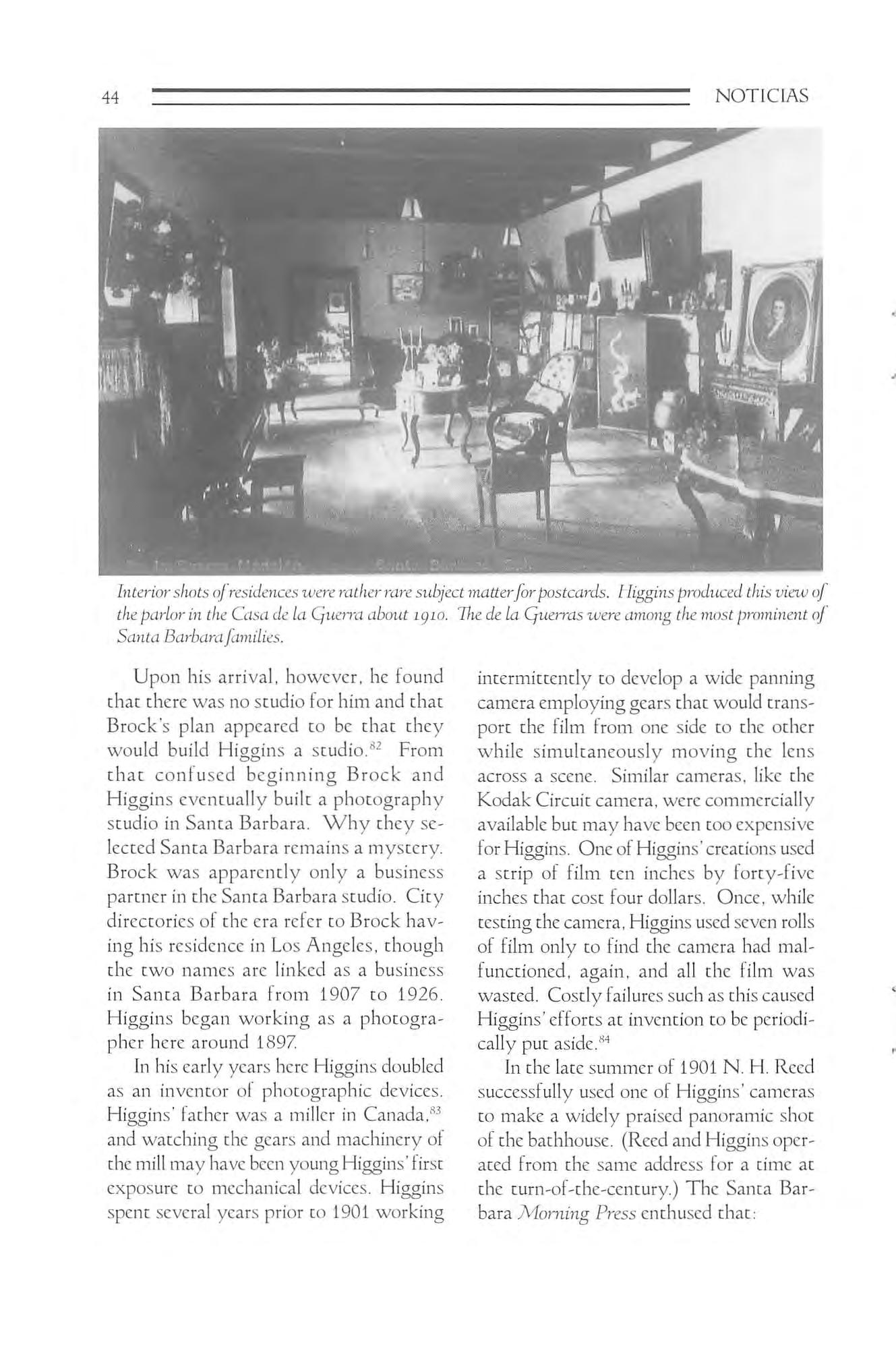
NOTICIAS 44
this view
were among the mostprominentoj
h is not only a worl^ of art, but pos~ sesses a greater merit in being thefirst ojits ki7id in Santa Barbara,and made by a machine invented by a Sa^ita Barbara man It is a machmcivhich cv~ ery photographerwillivant,andsoon as Mr. Higgins can arrive at the peijee-' tion which he hopes, he u’ill patent the invention and place it before the trade.^^
Higgins was also involved in helping produce some of the early editions ofSanta Barbara High School's yearbook. Oliveand Qold. The manager ot the 1912 Olive and Qold adds a special note of appreciation for the studio:

VVe call the attention of our patrons to the fine art photography in this number. It is work ofthe BRpCK' IJiqqiNS STUDIO, and we are justly proud of it. Mr. Higgitis has
7uade the picturesfor the "Olive and Cfold"for several years and the artistic success ofour magazine has been largely due to thisfact. Sn
Higgins’ daughter. Norah. known within the taniily as Nonnic, wrote in her memoirs that;
Father Peter oj the S. B. Mission and myfather were good friends and Dad zvoidd have FatherPetersitforpictures, giving him a large oneframed to hang in the mission .. . Dad ivas inMgued with the romance and religious history of the California missions.^~
The Brock-Higgins studio ran adver tising in the Olive and qold over many years. Tlieir ads were unique for the folksy messages that always concluded with the advice to have photographs taken by
CesareLaMonicaand hisbandfniton outdoorconccrt.sin Sa,nta Barbara in theearly 1900s. Higgins tookthisshotin igog;LaMonicaleft SantaBarbaraforMiami,FL>rida,five yearslater.
POSTCARD PHOTOGRAPHY 45
Brock-Higgins. A 1911 ad carried the message:
Forybur Christmas Qijts:Your PhotO' graph as a gift to yourfriends iviLt give more real pleasure to them and less trouble to you, than a more costly gift they may never care to use. 'Ihis Studio's Work is made to please. (i.H \
One year Higgins made a family Christmas card featuring a hand-tinted photo of the Fifth Street (later renamed Quinto Street)family home.Inside was the message;
A Hearth and a I\after, Sunshine and Laughter, Then Heaven Thereafter Tis OurSanta Barbara Home.^‘^
That home is now gone, Higgins placed hundreds of diHcrenc views of Santa Barbara on photo post cards. His subjects reflected the entire community. He photographed buildings and private homes, both interior and ex terior; individuals and groups in clubs and Iraternal organizations; hotels; sce nic views; local Chinese children in tra ditional costume; and roads and drive ways. Higgins may also have produced the only complete photographic post card set of views of all the local el ementary schools. Most oi his cards feature a brief title across the bottom followed by "Brock-Higgins." Never is Higgins' name separate Irom the "Brock-Higgins" designation.
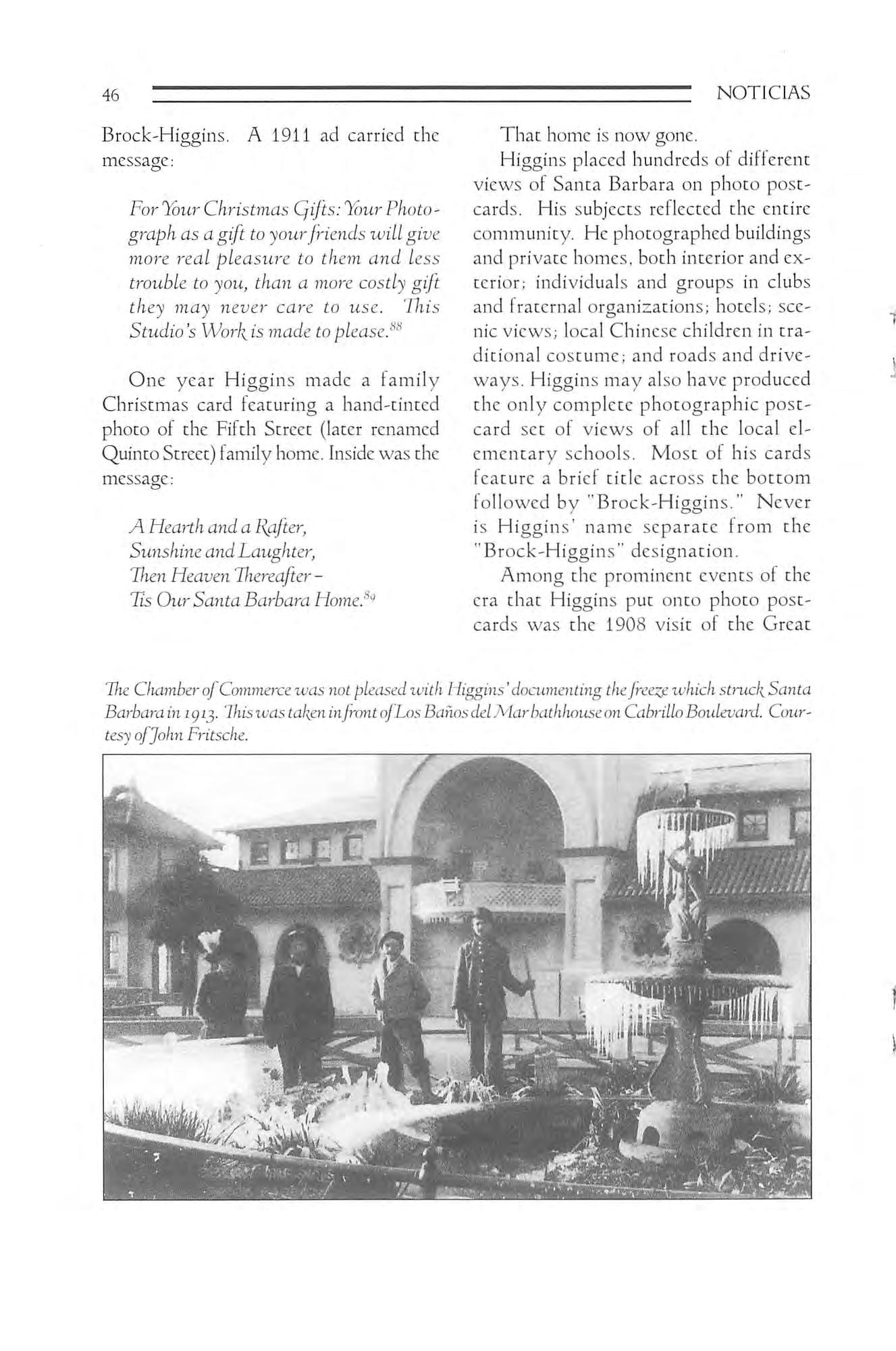
Among the prominent events ot the era that Higgins put onto photo post cards was the 1908 visit of the Great
The ChamberojCommerceivas not plctised ivith Iliggins’documenting theJree:y ivhich struckSanta Barbarain 2913. 'Ihisivastaken infrontofLosBaiiosdelMarbathhouseon Cahrillo Bcnilevard. Cour tesy ofJohn Fritsche.
NOTICIAS 46
^ ^'1 W >0;^A>V.—V,..-«3 ●V
90
White Fleet, and the massive flooding from the 1914 storm that struck Santa Barbara. In 1913 Higgins extensively photographed the results of a freak ice storm that struck the city. His black and white photo postcards of long icicles hanging from landmarks on Cabrillo Boulevard were a commercial hit until a posse of gentlemen from the Chamber of Commerce swept in and swooped up all the postcards of icicles. They declared that it was not the Santa Barbara image they wished to project.
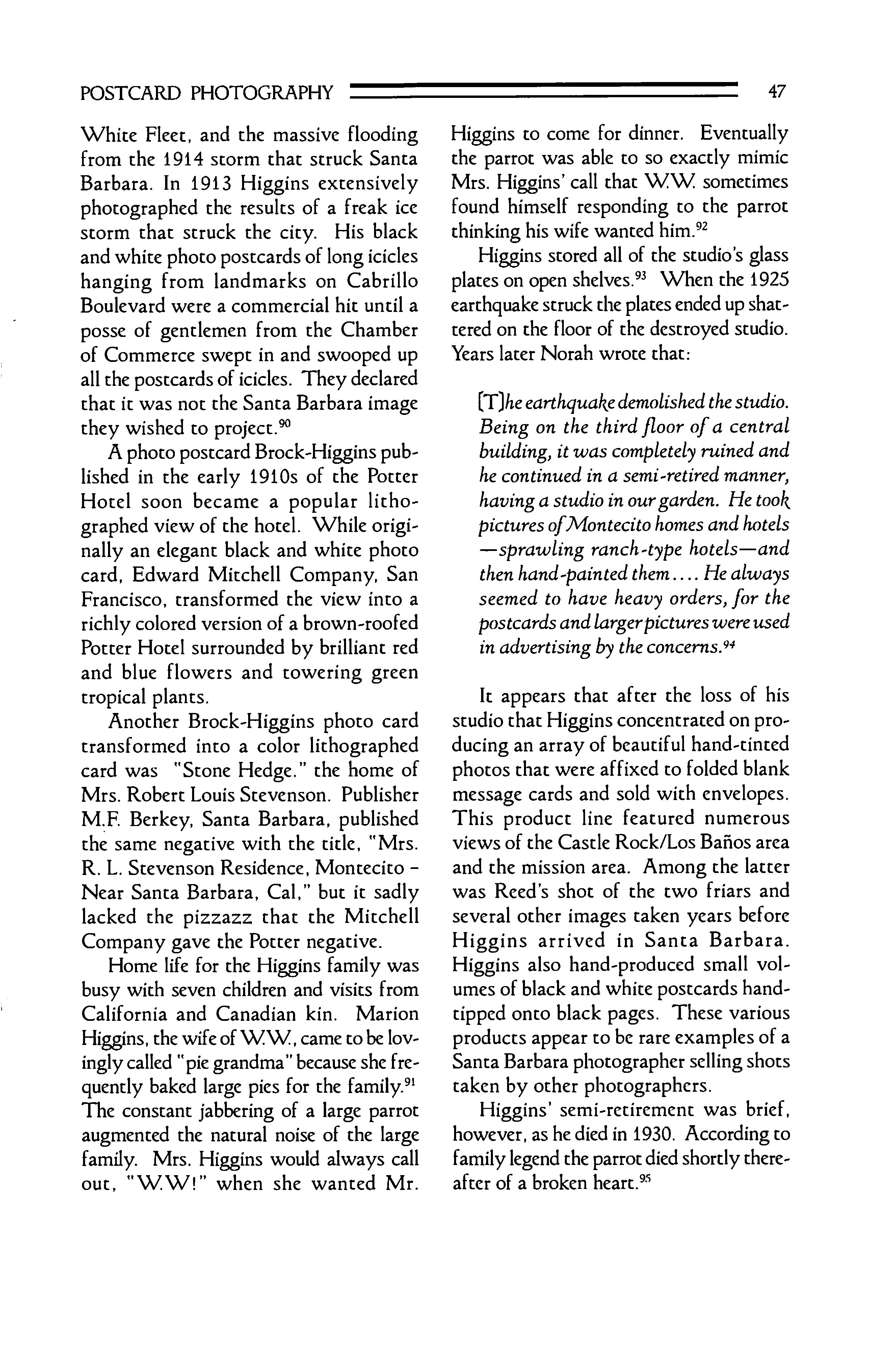
A photo postcard Brock-Higgins pub lished in the early 1910s of the Potter Hotel soon became a popular litho graphed view of the hotel. While origi nally an elegant black and white photo card, Edward Mitchell Company, San Francisco, transformed the view into a richly colored version of a brown-roofed Potter Hotel surrounded by brilliant red and blue flowers and towering green tropical plants.
Another Brock-Higgins photo card transformed into a color lithographed card was "Stone Hedge.” the home of Mrs.Robert Louis Stevenson. Publisher M.F Berkey, Santa Barbara, published the same negative with the title, "Mrs. R.L. Stevenson Residence. Montecito Near Santa Barbara, Cal.” but it sadly lacked the pizzazz that the Mitchell Company gave the Potter negative.
Home life for the Higgins family was busy with seven children and visits from California and Canadian kin. Marion Higgins,the wife of WW,came to be lov ingly called "pie grandma”because she fre quently baked large pies for the family.®* TTie constant jabbering of a large parrot augmented the natural noise of the large family. Mrs. Higgins would always call out, "WW!” when she wanted Mr.
Higgins to come for dinner. Eventually the parrot was able to so exactly mimic Mrs. Higgins’ call that WW sometimes found himself responding to the parrot thinking his wife wanted him.
92
Higgins stored all of the studio’s glass plates on open shelves. When the 1925 earthquake struck the plates ended up shat' tered on the floor of the destroyed studio. Years later Norah wrote that:
tr]heearthquakedemolished thestudio. Being on the third floor ofa central building,it was completely ruined and he continued in a semi-retired manner, having a studio in ourgarden. He took pictures ofMontecito homesand hotels —sprawling ranch-type hotels—and then hand-painted them....He always seemed to have heavy orders,for the postcardsand largerpictures wereused in advertising by the concerns.
94
It appears that after the loss of his studio that Higgins concentrated on pro ducing an array of beautiful hand-tinted photos that were affixed to folded blank message cards and sold with envelopes. This product line featured numerous views of the Castle Rock/Los Banos area and the mission area. Among the latter was Reed’s shot of the two friars and several other images taken years before Higgins arrived in Santa Barbara. Higgins also hand-produced small vol umes of black and white postcards handtipped onto black pages. These various products appear to be rare examples of a Santa Barbara photographer selling shots taken by other photographers.
Higgins’ semi-retirement was brief, however,as he died in 1930. According to family legend the parrotdied shortly there after of a broken heart.®'^
47 POSTCARD PHOTOGRAPHY
Edwin(Ed)Rick(1888-1978) (Active Santa Barbara,ca. 1912-1968)
Edwin(Ed)Rick arrived in Santa Bar bara about 1910 and went to work as a bellboy at the Potter Hotel. Riding the rails west from Brooklyn, Indiana, Rick had camped out while working as a bell boy in various hotels en route and had also gone door-to-door selling "residential” pho tography along the way.^^ Rick started in photography in 1902, when he purchased a mail-order photography kit that included glass plates,chemicals,and flash powder. Within a couple of years he had the logo, "Rick Photography Brooklyn, Ind.” sten ciled on some of his photography gear. By the spring of 1914,Rick had taken on a second job as a clerk at Jackson & Semmelmyer, a photo supply business at 913 State Street. Jackson & Semmel myer was one ofthree businesses spanning the 900-1100 blocks of State Street that specialized in photographic supplies. In ad dition to these stores, moststudios also sold photo supplies such as chemicals,film,and paper,asdid some stationery supply stores.
A 1914 Santa Barbara newspaper con tained ashort notice,"Edwin Rick resigned today as one of the bell men of the Potter, and left this afternoon for Los Angeles, where he will spend a short vacation, be fore returning here toenter the photograph business.
98 99 ”101
Sometime in 1914 or early 1915 Rick began processing film at the Flying A mo tion picture studio located on Mission Street. 102 For a time he worked for the
National Film Corporation in Denver as laboratory superintendent in charge of de veloping film for projects there. He re counted that experience in his personal notes, writing, "I had charge of a moving picture Laboratory, $50 per week for 6 months. Put me in business.’’’"^ At the Flying A Rick did some motion picture filming and still photography of stars. He was very proud ofa candid still photograph he took of young Clark Gable in front of the Potter Hotel. At the time of his retire ment in 1968, however, Rick groused to the Santa Barbara News-Press that while the work at Flying A had been interesting, he eventually got "tired of taking pictures of Mary Miles Minter and making prints of them by the thousands for her fans. A famous photograph of the era poses Minter, a huge star of the silent film era, standing between twostacks of promotion photos as tall as she was.

Rick opened his first small shop at 301 State Street in 1915. There he sold photo products,did processing and printing,and took portraits in the front. He advertised "Any roll of film developed, 10 cents. In an effort to gain a share of the market printing customers’negatives as postcards, Rick had a sign at hisfront door and a mes sage stamped onto the back of his prints offering to put a customer’s "photo on a postal.’’ In 1921 Rick moved afew steps
up the street and took over Mrs. E. E. Leach’s photo studio at 401 State Street. He initially processed only a few rolls ofcustomers’film per day,and was haunted by a fear of failure. He expressed this to
48 NOTICIAS
'105
106
Ric/i’s postcard oj the Qranada Ikeatre, Santa Barbara’sfirst "skyscraper,”tt’cLs tafitn shortly after the InUldmg!s opening in the sp>ringoJ Ihecardivaspublished by Osborne'sBook Store.
"UM In his early years Rick also
Santa Barbara dentist Louis Rczzonico, who advised him co "stay with it, you’ll make it, did photography and developing tor the Daily Neivs and the Morning Press newspapers.
Over the years, Rick occupied numer ous lower State Street locations. Even chough he sold pre-mixed dry chemicals to photography amateurs,Rick always mixed his film developer from scratch for his own work. Rick’s primary film developer was a tormula called DK-20, a mixture ot
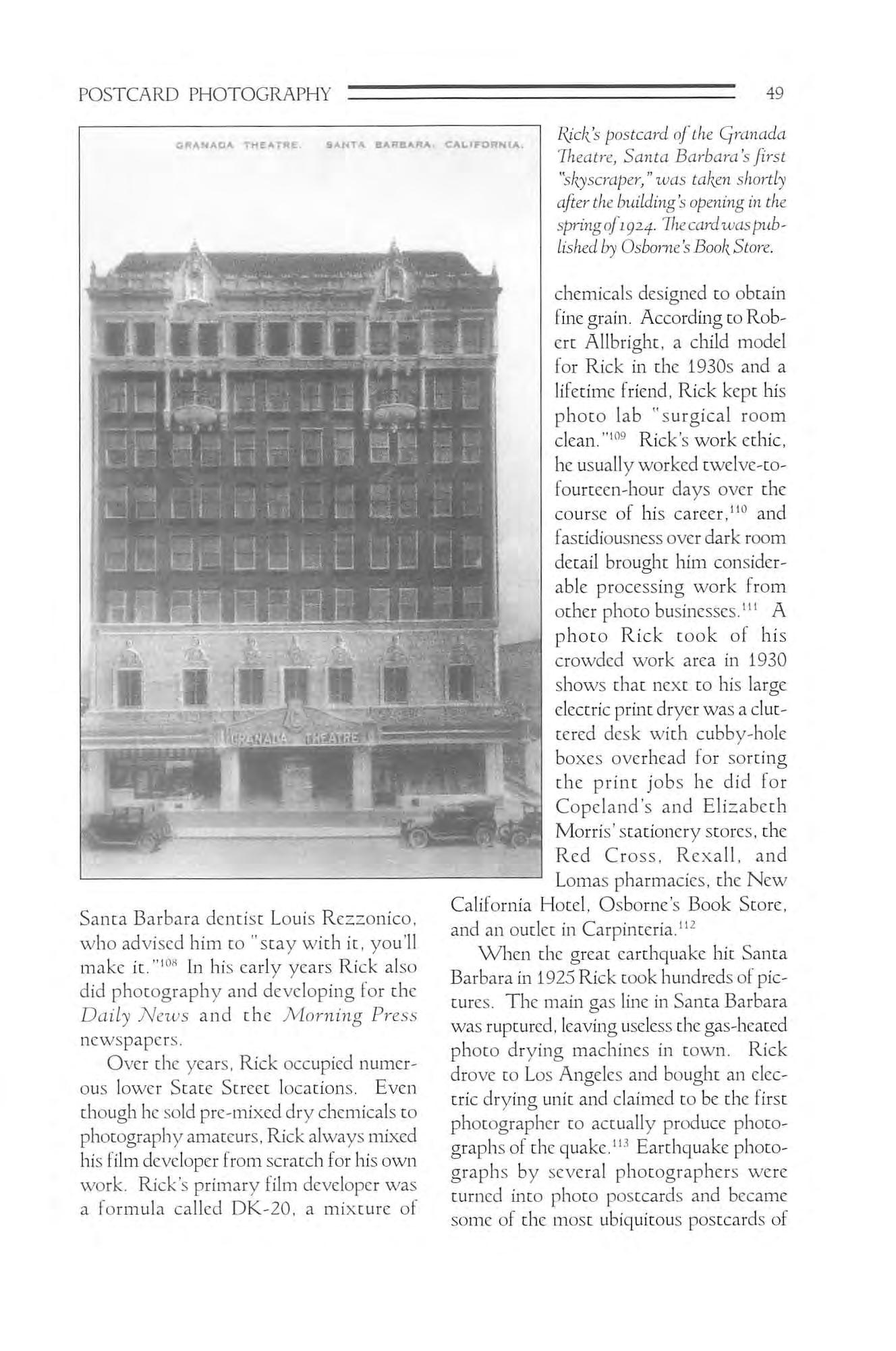
chemicals designed co obtain line grain. According co Rob ert Allbright. a child model for Rick in the 1930s and a lifetime friend, Rick kept his photo lab "surgical room clean."’"® Rick’s work ethic, he usually worked cwclvc-tofourtecn-hour days over the course of his career,"" and tascidiousness over dark room detail brought him consider able processing work from ocher photo businesses, photo Rick cook of his crowded work area in 1930 shov.^ that next co his large electric print dryer was a clut tered desk with cubby-hole boxes overhead for sorting the print jobs he did for Copeland’s and Elizabeth Morris’stationery scores,the Red Cross. Rcxall, and Lomas pharmacies, the New California Hotel, Osborne’s Book Score, and an outlet in Carpintcria. When the great earthquake hit Santa Barbara in 1925 Rick cook hundreds ot pic tures. The main gas line in Santa Barbara was ruptured,leaviiig useless the gas-hcaced photo drying machines in town. Rick drove co Los Angeles and bought an elec tric drying unit and claimed co be the first photographer co actually prtxluce photo graphs of the quake. Earthquake photo graphs by several photographers were turned into photo postcards and became some ot the most ubiquitous postcards of
111 A 112
49 POSTCARD PHOTOGRAPHY
BARBARA. CALirORNiA. SRANAOA THEATRt
SANTA
chc late 1920s. A postcard ot damage along State Street titled, "2. El Camino Real Hotel,” shows a stylishly dressed woman on the distant right facing the camera. That woman was Ride’s girlfriend of the time. She peddled the earthquake cards in chc streets while Rick continued photo graphing and processing.‘ That one-two punch of getting a photo drying unit and having his girllricnd sell postcards in the streets in the days immediately following the quake led to Rick selling a huge vol ume ol earthquake photo postcards.
Rick ttx>k great j:>lcasurc in posing rela tives and Ihends in hisearthquake cards. His card titled,'6.Pythian Building and Van Ness Hotel,” has Charles Chapman, Rick's brother-in-law, placed in the ioreground look ing at rubble,wliile Rick’s nephew,Raymond Morrison, stands behind Chapman staring at the destroyed hotel. Chapman was a Santa Barbara house painter and former
Methodist minister. Rick was living with the Chapmans at this time lollowing the dis solution ot his first marriage. Rick has in serted his sister, Mary Rick Morri.son, her husband Bert Morrison, and their son Raymond into his earthquake card of the li brary that is unnumbered in one version but signed "Rick SB."
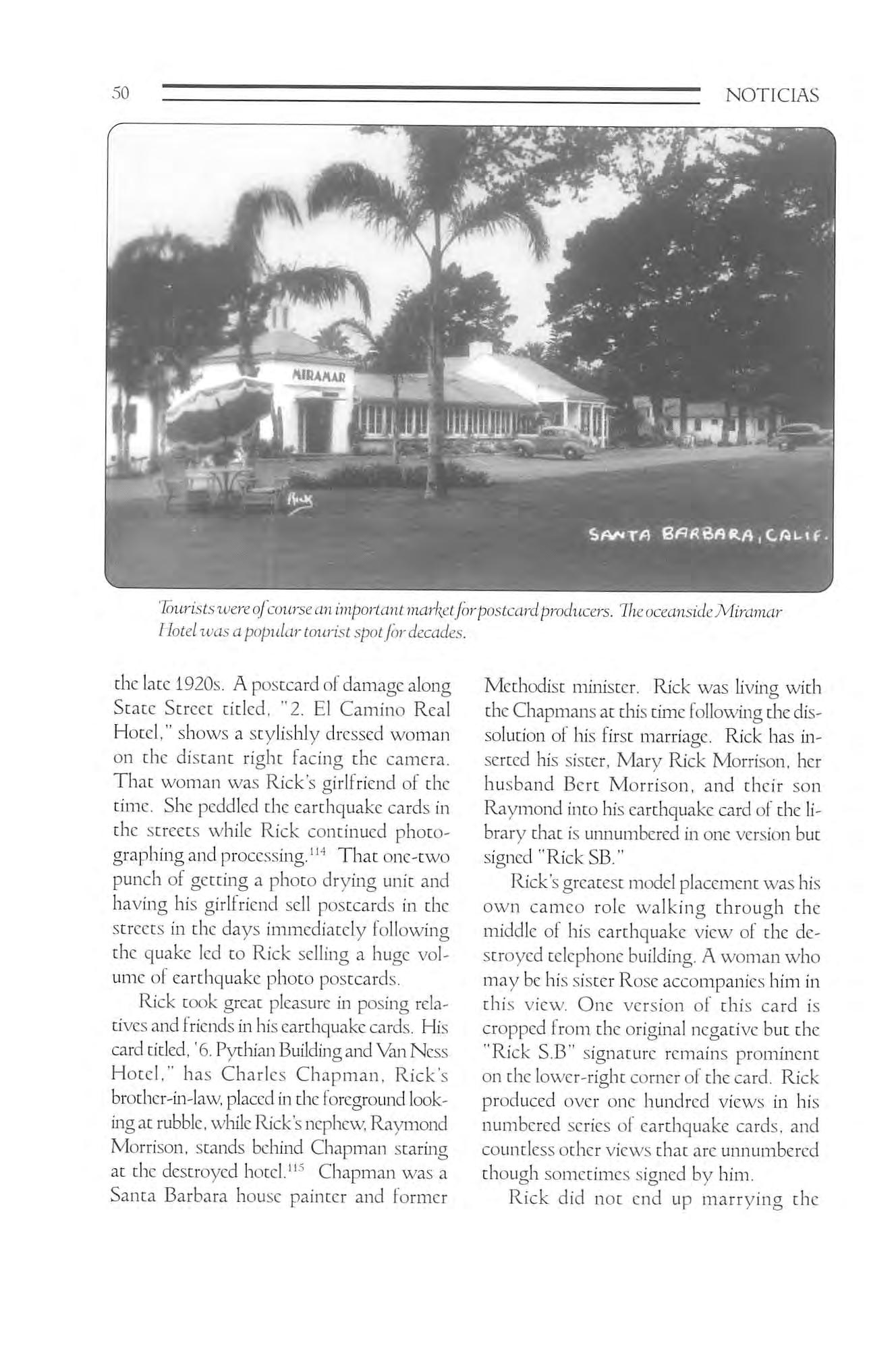
Rick’s greatest mtxlel placement was his own cameo role walking through the middle of his earthquake view of the de stroyed telephone building, A woman who may be his sister Rose accompanies him in this view. One version of this card is cropped from the original negative but the "Rick S.B” signature remains prominent on the lower-right corner of the card. Rick produced over one hundred views in his numbered series of earthquake cards, and countless other views that are unnumbered though sometimes signed by him.
Rick did not end up marrying the
NOTICIAS
'Iburist^ivereofcourseciJi mporLint7narj{ctforpostcardprndicc Ilotdivasd populartouristspotjdrdecodes. teas. IhcOceansideMiramar
woman who worked with him on the earthquake cards. The woman who be came Rick’s second wife, Alice Shellborn,
arrived in Santa Barbara from Canada in 1926.
Marriage was preceded by a yearS'long courtship during which Rick and Shellborn cook hundreds of pictures ot themselves posing in local parks, in front of Rick’s shops, on top of houses, at the beach in both baching suits and lancy apparel, and especially, in dozens ol poses with Rick’s cars.
It is clear from the pictures that the couple was lun-loving and perhaps a bit wild. Rick certainly had a wild side to him. On one of their crips to Los Angeles in his fancy Buick, individuals they feared to be gangsters pulled up alongside them. Rick, suspecting chat the hoodlums were going
to try CO run them off the road and steal cheBuick, yelled at Alice to duck. He then grabbed a Lugar pistol he carried and started shooting out the window of the passenger side ol the car. just inches above Alice’s head. Tlic suspects in the other car quickly disappeared,"'
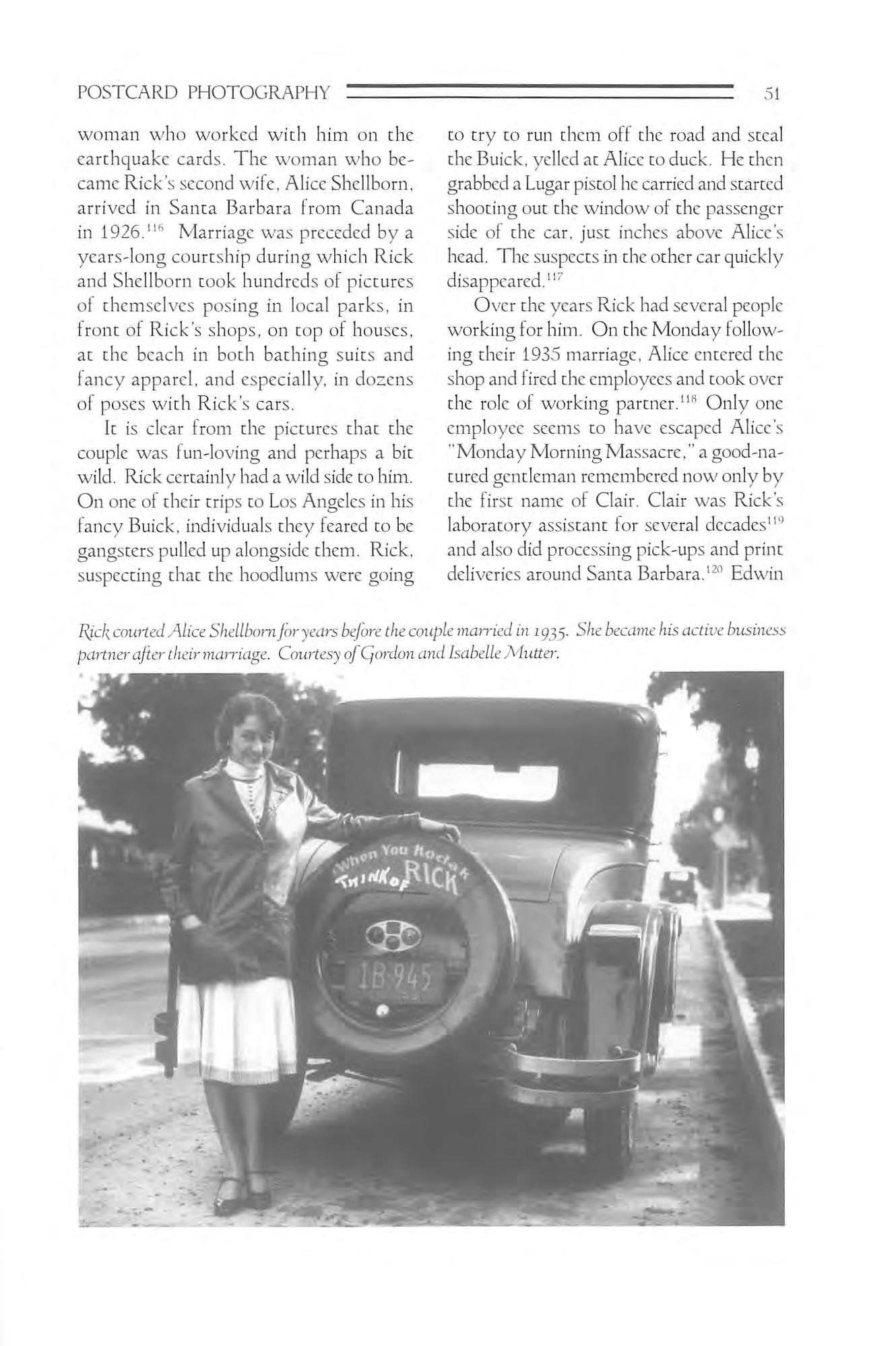
Over the years Rick had several people working for him. On the Monday follow ing their 1935 marriage. Alice entered the shop and Hred the employees and took over the role of working partner."^ Only one employee seems to have escaped Alice’s "Monday Morning Massacre.” a good-na tured gentleman remembered now only by the first name of Clair. Clair was Rick’s laboratory assistant lor several decades and also did processing pick-ups and print deliveries around Santa Barbara. Edwin
ii«)
POSTCARD PHOTOGRAPHY 51
It6
R}ckcourted AliceShdlbomjoryearsbeforethecouple married in 1935. She became hisactive business paHneraftertheirmairiage. Courtesy ofQordonandIsabelleMutter.
inevitably had to add a tew workers as business grew, although it fell to Alice to always keep the payroll to a minimum.
From about 1933 until about 1937 Rick had his studio and shop at 502 State Street and also operated Rick's Kodak Laboratory at 130 W GutierrezStreet. Rick had moved the Gutierrez buildingfrom another location. It must have been cozy inside;the Ricks lived at this site, operated the laboratory there, housed Alice’s mother there, and regularly rented rooms to railroad engineers overnighting in Santa Barbara.

i’i 122
Alice and her mother.Amanda Shellborn, Rick's sister Rose Chapman,and other fam ily members worked for Rick doing the handcolored tinting that was popular prior to the widespread introduction of color film and prints. Rick’s dcscendcnts remember that he worked hard to take care of his family through the Depression.
In addition to taking charge of the retail portion of the businesses, Alice also processed
prints and assisted in the portrait studio. Robert Allbright recalled having his portrait taken by Edwin and Alice around 1938, "Bobby,” he remembers her saying to him in a Swedish accent, "we arc almost through now and we have some coffee and dough nuts for you. just a little while longer now. Be patient. Tlic source of Allbright’scon¬ sternation, and the sour expression on his face, was the heat and intensity of the huge lights Rick used to illuminate the scene for his giant view camera.
Rick took large format photos of the retail, portrait, and darkroom areas of his studios. In nearly every photograph of the retail section of his businesses photo post cards arc displayed for sale.'^’’ In the latter 1920s a sign above the display made a dis tinction between black-and-white photo postcards and "Hand Colored” postcards, the latter being more expensive. By the 1940s his displays show that he was charg ing five cents for a photo postcard, but
NOTICIAS 52
Hickused threeojhisfamily members,atleft,in thispostcardofthepubliclibrary,ivhich wasdamagedin theeat-thquakeoffline 1925. CourtesyofJohn Fntsche.
lithographed color cards were three for five cents.
1 26 Robert ■
1 .’7 concurs ^
According to Bill Lennon,an em ployee of Fred Anderson Studio al ter World War II, it was common tor photo shops to sell their own photo postcards, Lennon noted, how ever, that an indi vidual photogra pher would be "most unlikely" to ■■ sell real photo postcards that were the work of a competi-| tor, Allbright that a photographer would probably not offer postcards, cs- ^ pecially photo postcards, taken by a " competing photog rapher, We can be reasonably certain, therefore,that Rick photographed most ol the photo post cards offered lor sale in his studios. The authorship ol lithographed cards might be a bit hazier,except when a photo postcard ol the identical scene can be viewed for sale in a shop photograph.
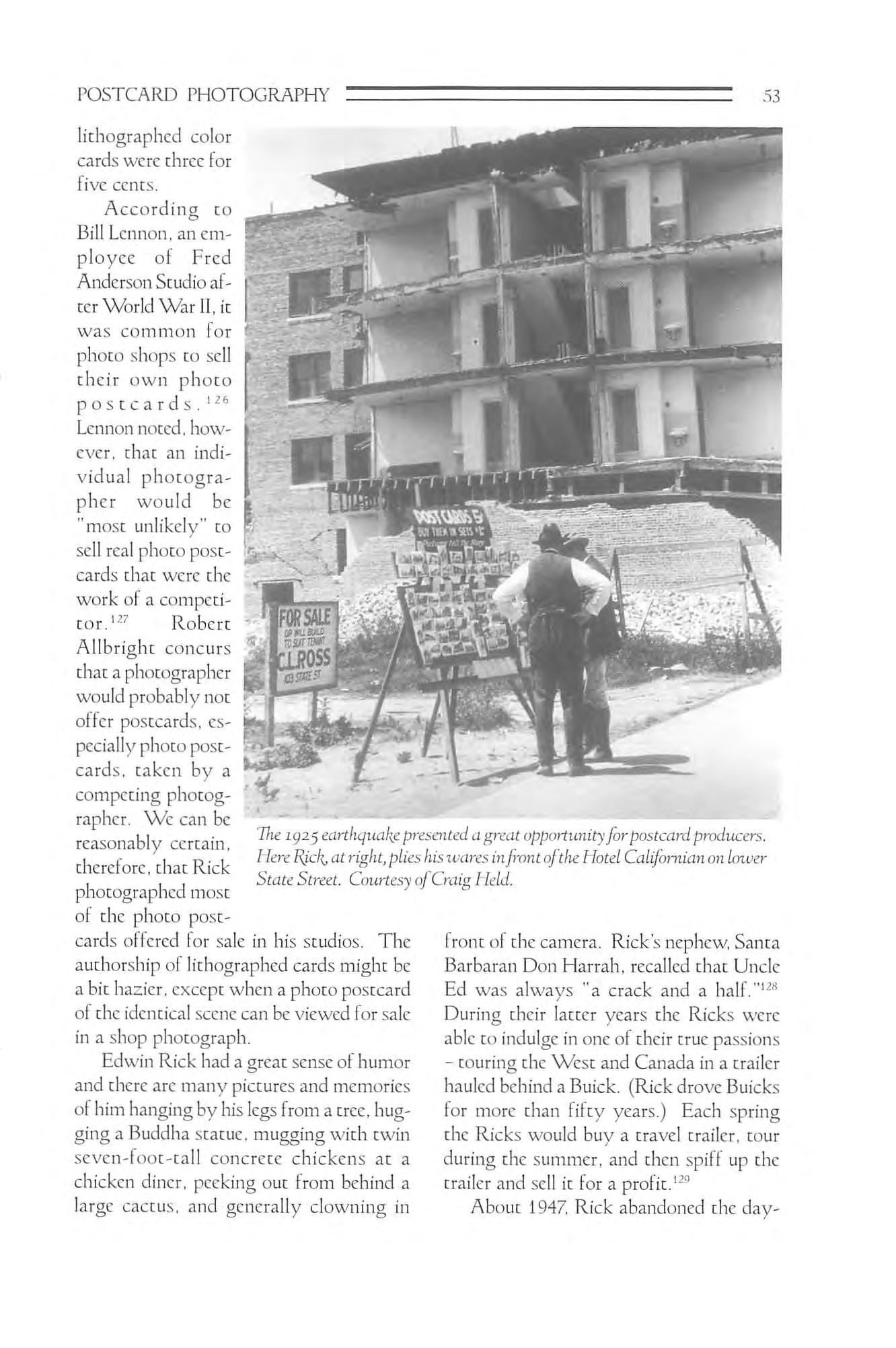
Iront of the camera. Rick’s nephew,Santa Barbaran Don Harrah, recalled that Unde was always "a crack and a half. During their latter years the Ricks were able to indulge in one of their true passions - touring the West and Canada in a trailer hauled behind a Buick.(Rick drove Buicks lor more than fifty years.) Each spring the Ricks would buy a travel trailer, tour during the summer, and then spiff up the trailer and sell it lor a profit.
Ed "128 129
About 1947, Rick abandoned the day-
POSTCARD PHOTOGRAPHY
Edwin Rick had a great sense of humor and there are many pictures and memories of him hanging by his legs from a tree,hug ging a Buddha statue, mugging with twin scvcn-loot-tall concrete chickens at a chicken diner, pecking out from behind a large cactus, and generally clowning in 8^
if
'Ihe1y,25earthquak<^presented dgreatopportunityJorpostcardproducers. HereR}ck,atright,plies hisivaresinfrontojthe Hotel Californian onloiuer StateStreet. Courtesy ofCraig Held.
co-day grind ofoperating a studio and store and contented himself doing the overflow black and white processing and printing for Wescen’s Photography. Edwin and Alice had a regular lunch dace at the Cop per Coffee Pot after Rick delivered the day’s film and prints to Westen’s. Rick shared some of this workload with his long-time friend,photographer Karl Obert. In the 1930s Obert and Rick established a professional and personal relationship chat would last decades. Rick didn’t like mak ing large prints, while Obert excelled at producing high-quality large prints. Obert, on the other hand, hated processing film. For decades Obert would have Rick de velop some of his black and white film in return for doingoversized enlargements for Rick or his customers.
Rick had few regrets about his life. Two significant regrets he spoke of, however, were losing control of most of his nega tives and prints, and losing nearly all of his work from the Flying A years and the earthquake. A private collector apparently acquired most of Rick’s commercial nega tives and prints from his later career and Rick had no access to them. According to a story passed down through Rick’s fam ily, Alice, sometime in the early 1930s, decided there was too much "old stuff”sit ting around the studio and hauled to the landfill most of the old negatives and prints. Someplace in Santa Barbara are thousands of negatives and prints from some of the Santa Barbara’s richest and most interesting history.
Hil
James Walter(J. W.)CoUinge (1883-1964)
(Active Santa Barbara, ca. 1918-early 1960s)
J. W Collinge was one of the most un likely individuals to become an accom plished photographer. From childhood Collinge was nearly deaf and almost blind. In the latter part of the nineteenth century his father worked on the railroad across the northern United States. Collinge was born in a small town in Montana and would later say that he was the first white baby born in the town.*^"^ The family con tinued moving west with the railroad con struction and settled at the end of the line in Portland, Oregon.

136
In Ashland, Oregon, Collinge appren ticed to a photographer. In 1900,Collinge won an Honorable Mention in a photogra phy competition sponsored by %uth’s Companion magazine. About this same time, his family relocated to Riverside, California, hoping the change would ben efit Walter’s health.^^*^
Collinge, despite his eyesight, drove a car as a tour guide for the Mission Inn in the early 1900s and kept camera gear in the car for any spontaneous opportunity to photograph the backcountry. Collinge simultaneously helped an uncle operate Collinge’s Studio Store,in Pomona,selling photo supplies and "original photographs and points of interest.” During the world wide flu outbreak of 1918 the family sent Collinge to live with relatives in Santa Bar-
NOTICIAS 54
IE EE
Good Kodak Finishing
12/7 State St.
bara to reduce his exposure to large crowds. Collinge and hisfamilyso loved Santa Bar bara. they moved here in 1919.
139 141
Given his eyesight, Collinge generally avoided the finely nuanced demands of portraiture, but he became a master of ar chitectural photography. One of his prin cipal sources of income was taking fine photographs of interiors and exteriors of mansions in Montecito.and compiling the photographs into handsome hand-bound portfolios for the owners. Among the estates he photographed were those of Max Fleischmann, George Owen Knapp, and John and Lolita Mitchell. Architects,such as George Washington Smith, befriended Collinge because of his fine treatment of their designs. He also did extensive pho tography of yachts,such as Fleischmann's Haida. both interiors and in seascapes.
Collinge is also recognized for his ex quisite photography cd nudes, female and
J'. W. ColUnge gets ready to takf a shot outside [Riverside, Califoniia, ca. igi8. Collinge carved out a successjid career as a photographer despite extremely poor eyesight. CourtesyofJho7nasSchmidt. male. Many of Collinge’s nudes uti lized the human form as an abstract clement in an Art Deco style, with the body as a form within the overall design of the image. Collinge’s vision and hearing limita tions didn't affect
this type of figure photography because the ability to meticulously arrange shapes and forms within the viewfinder frame was more important than the precise timing and instant reflexes needed in some other pho tography.
According to Bill Lennon,a Santa Bar bara amateur photographer active from the 1930s to the 2000s, "Collinge often made nudes of well-to-do ladies of Montecito in their younger years. He photographed nudes in a wide variety of seashore, wood land. and garden settings. His nude stud ies reveal an almost quaint innocence when compared to most of today's figure pho tography. Collinge arranged some of his nude studies into sumptuous handmade books he distributed to friends.
One of Collinge's most famous photo graphs in this genre."Tine Fairy Ring.”fea turing dancer Doris Humphrey of the re nowned Denishawn Company,is actually
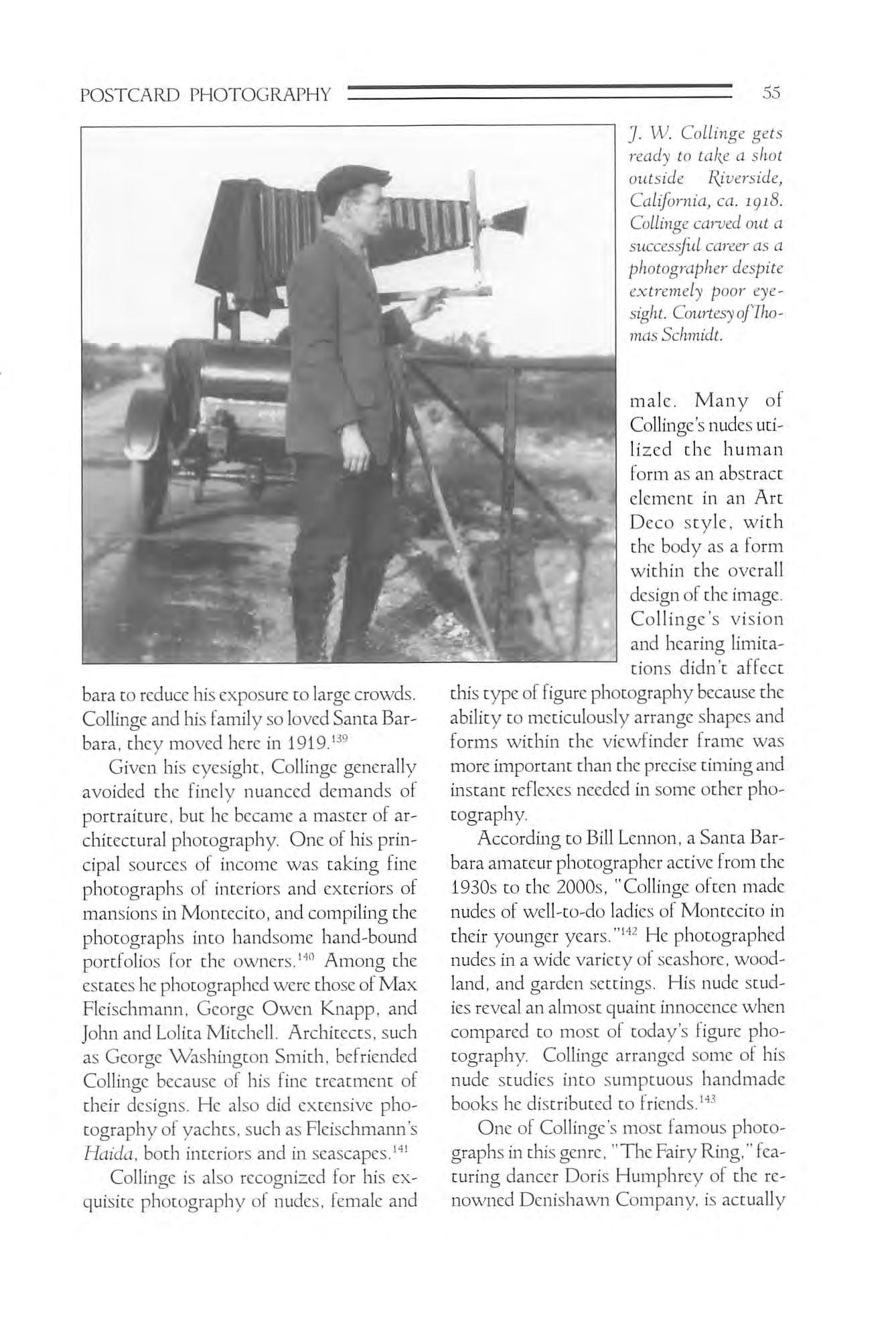
55 POSTCARD PHOTOGRAPHY
not a nude. Close inspection shows Humphrey wearing a very snug fitting chemise. Most of Collinge'sextensive pho tography oi the Ruth St. Denis male and
female dancers, however, arc true nude studies in settings ranging from theatrical sets to seashores.
Collinge's architectural,scenic,and nude
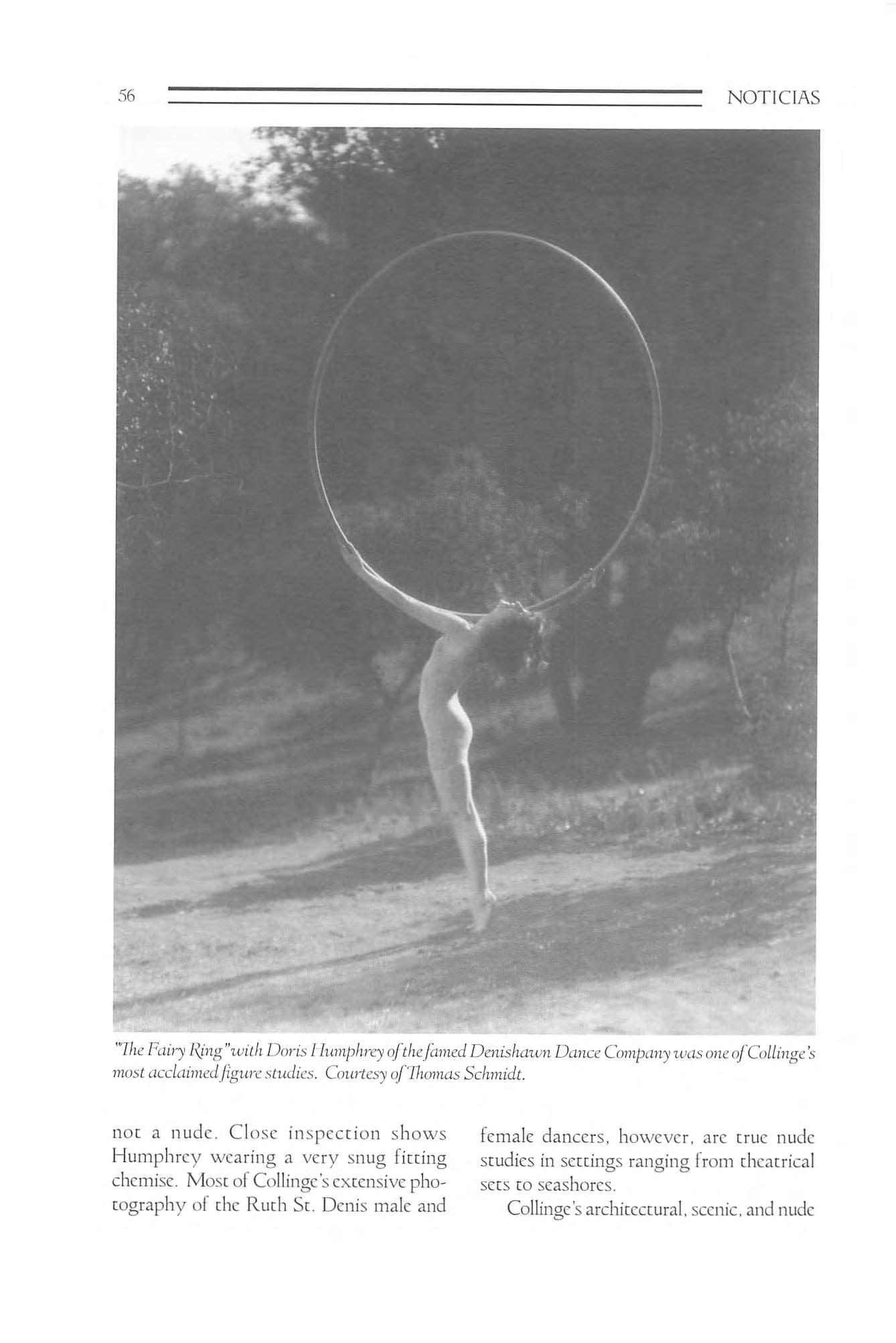
56 NOTICIAS
'7/ieFairyl^ng"with D(trisIbimpkreyofthefamedDenishaivn DanceCompanywasoneofCoLlmge's mostacclaimedJigiircstudies. Courtesyof'lhomasSchmidt.
photography was in high demand for American and international salon exhibi tion during the 1920s and 1930s and re ceived numerous awards. "The Fairy Ring,"for example,garnered awardsfrom top salons from the United States to Paris.
In the early 1920s.Collinge operated out of the San Marcos Building. By 1925 he was set to move to a better location across the street. Collinge was out in the street early on the morning of June 29. 1925, to begin moving his equipment and cameras when the great earthquake suddenly struck, Collinge watched the San Marcos Build-
ing collapse, destroying his cameras,dark room equipment, negatives, and many prints. Three people died in the building. Rather than trying to recover his equip ment Collinge left to check on the welfare of his family, and found everyone to be safe.''^''' Peg Collinge, Collinge’s daughterin-law, felt that he never quite recovered from the financial shock of the quake. The rebuilding of Santa Barbara ironically offered Collinge dozens of new architec tural subjects for his cameras.
146
By 1926-27,Collinge wassimultaneously operating out of 1217 State Street and 21 East De La Guerra Street, the latter used for the sale of photo graphic supplies. Over the course of his career Collinge would operate from at least seven locations in Santa Bar bara. Collingc’s wile, Florence Margaret Foster, who sported dark waist-length hair and sometimes appeared in his pho tographs, ran the family's re tail operations.
Daughter-in-law Peg Colliiigc supported Walter in one of his most durable con tracts as photographer for Burpee seed catalogs. She would drive Collinge in his two-seater Ford, pulling a tear drop trailer packed with gear, to Lompoc for photo sessions with the company. Much of this work was done on 8x10
Collinge’ssenseofznmpositionmay be seen in this mterior view ofthe Mcirgui-etBaylorInn.IhisIwteLJor wmnenonAnacapaStreetwasde signed by Julia JAorgan,architect of William Ikarsts residence at SanSimeon.
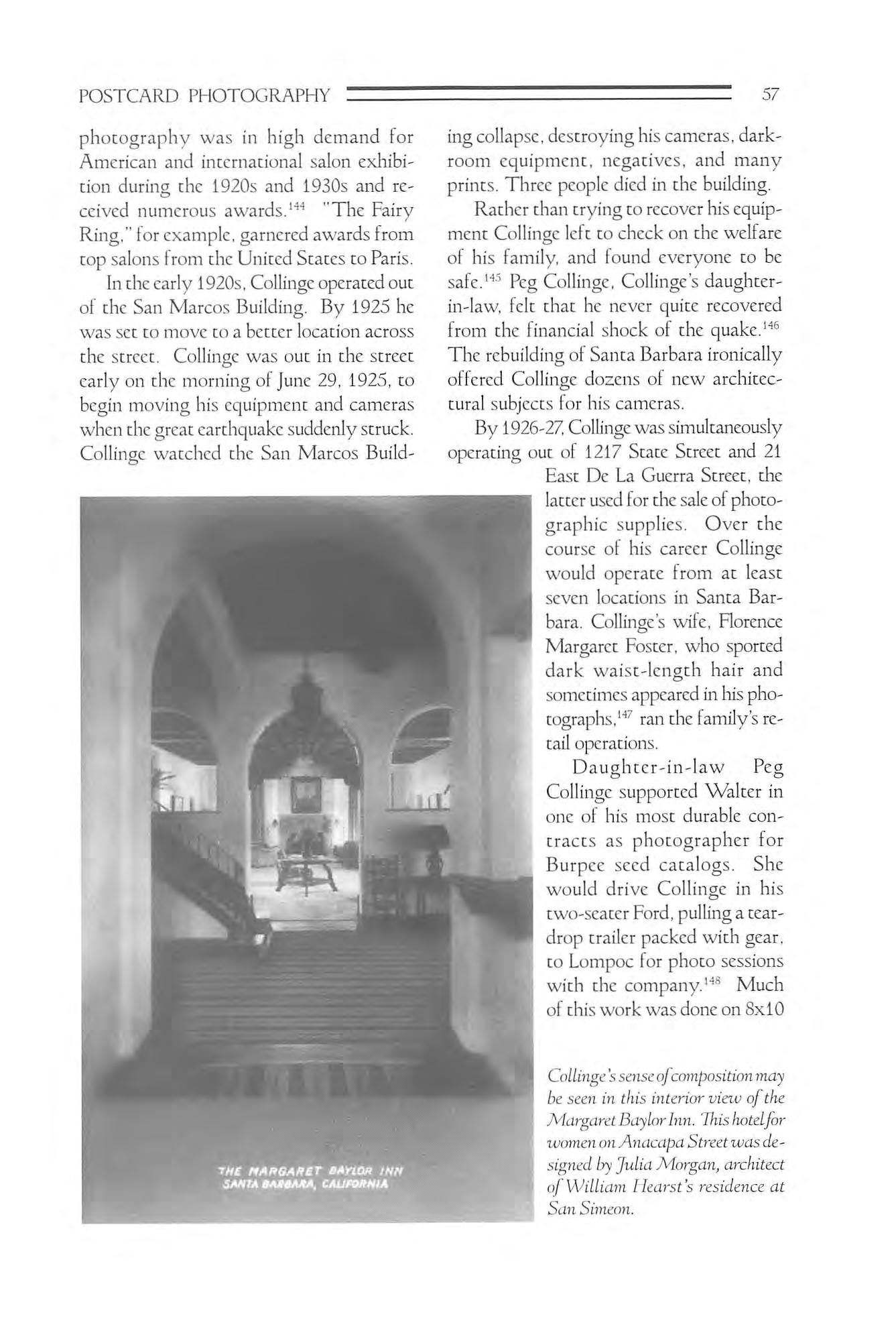
57 POSTCARD PHOTOGRAPHY
7H£ MARGAKST BAYIOR INN SANTA BARBARA. CAURORHIA
Kodachromc™ slide film chac was taken to Anderson's Photo Service for process ing, Lennon, who worked at Anderson's alter World War II. remembers receiving Collinge’s film and packing it off to Roch ester. New York, tor processing. While a number ot Kodak labs around the country could process Kodachromc . Lennon and Collinge tele the Rochester lab had the high est quality processing. Lennon felt that these huge color slides were so beautiful that they could have been hung for viewing like stained glass windows.
M9 t.^o Nev151
Late in his life Collinge destroyed many of his own negatives. Collinge historian and collector Thomas Schmidt believes Collinge destroyed his own work out of Irustration that he would never achieve the acclaim he had hoped to attain, erthcless, Peg Collinge loLind, many years after her father-in-law's death, a crunk in the family home filled with negatives.
Collinge's black and white photo postcards are principally architectural. Some of the photo post cards were also handtinted. He published his postcards as "California Pictures", usually with a title on the front of the card. Framing the front of the mission in the boughs ot a pepper tree showed a master’s control of space and form. His distant pho tographs of the Samar kand reveal the same sig nificant skill at utilizing delicate lighting chat made his nude studies successful. His classic photography of
the Arlington and Samarkand hotels was never bettered.
Some whoknew Collinge felt hisimpaired vision and difficulty in discerning fine detail actuallyforced him to utilize form and space in a more artful way than most ocher pho tographers.'^^ Tliis photographic sensibil ity,defined by both grace and power in many of his photographs, made Collinge one of the most revered and collected ofSanta Barbara’s early photographers.
7/ie romance ofSanta Barbara’s Old Sl^anisk Days Fiesta is captured in this Collinge image Jrom 1gz^.JustasthefloralfestivalsofR^edsday u'erepopularsubjectsforphotographeis,soFiesta became a staple ofpostcard production. Collection oftheSantaBarbara HistoricalSociety.

58 NOTICIAS
%
Santa Barbara and Postcards
Profit was the primary motive behind Santa Barbara’searly photographers to cre ate postcards. Their selection of subjects has served the purpose of creating a re markable historical record of the places, people,and events of their respective eras. Postcard production and distribution was a highly competitive arena, as photogra phers sought to out-do their rivals with more interesting,better-composed,and upto-the-minute images.The result wasa par ticularly rich view of the evolution of the South Coast.
In this selective survey, it is not pos sible to include or mention all producers of
Santa Barbara postcards. Some highly dis^ tinguished photographers dabbled in the postcard field includingJessie Tarbox Beals and Karl Obert. There was also any number of photographers, professional and amateur,who occasionally placed their im ages on postcards, but never achieved any fame or distinction. In some cases their names are lost to history.
even
Norman H. Reed, W W Higgins, Edwin Rick,and James Walter Collinge achieved special status with their post cards views. The number and quality of the images they produced between 1898 and 1930 make for a unique contribution to the visual and historical record of the Santa Barbara region.
NOTES
1 Daily Indepcndait{Santa Barbara), 18 July 188Z
^ Morning Press(Santa Barbara), 26January 1900.
^ SantaBarbara City Directory 1915-16(Santa Barbara: Santa Barbara Directory Company. 1915).
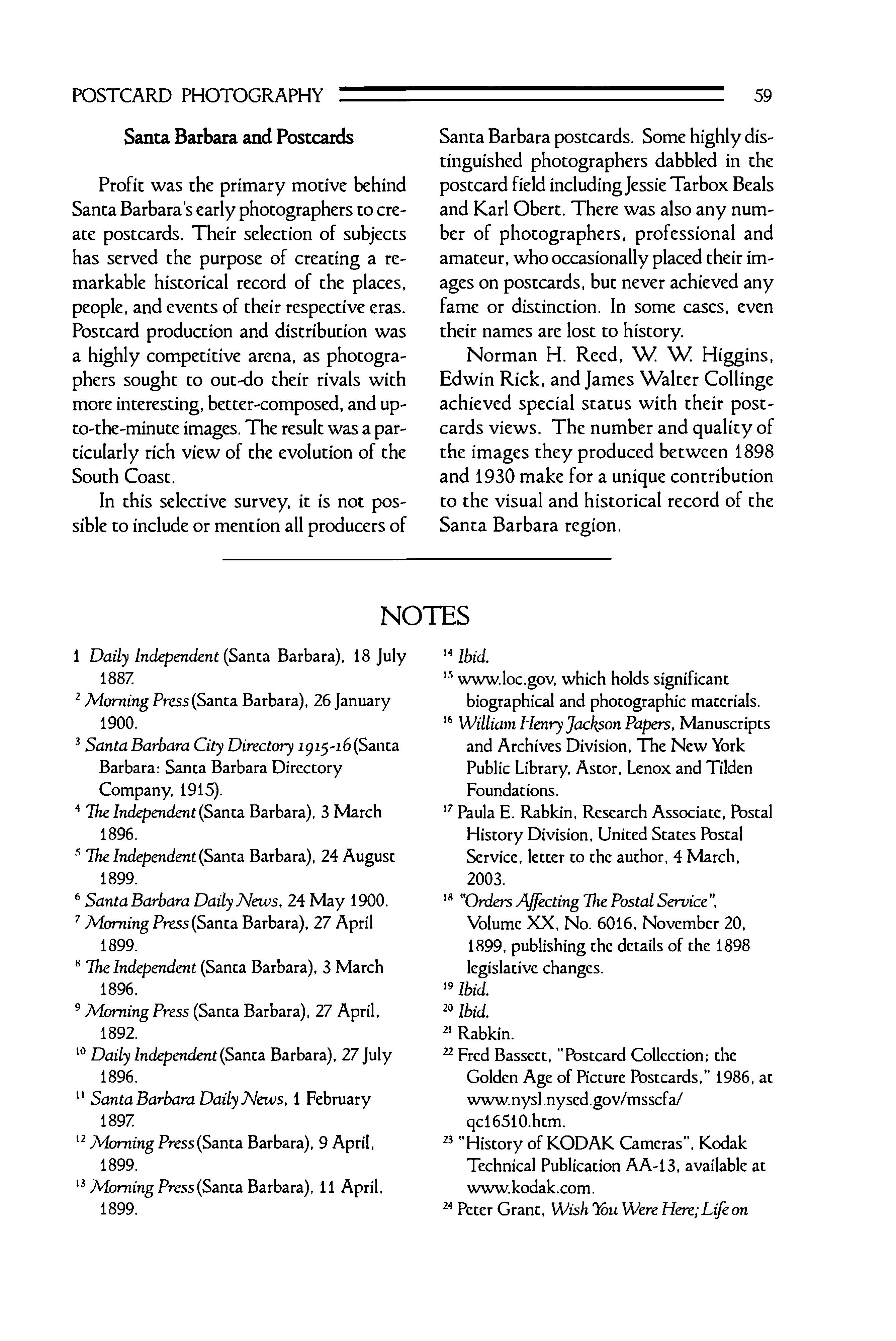
TheIndependent{Santa Barbara). 3 March 1896.
TheIndependent{Santa Barbara), 24 August 1899.
^ SantaBarbara Daily News,24 May 1900.
^ A4ormng Press(Santa Barbara),27 April 1899.
** TheIndependent(Santa Barbara),3 March 1896.
^ Morning Press(Santa Barbara), 27 April, 1892.
10 12
Daily Independent{Santa Barbara),27July 1896.
SantaBarbara Daily News,1 February 1897
Morning Press(Santa Barbara),9 April, 1899.
Afoming Press(Santa Barbara), 11 April. 1899.
Ibid. www.loc.gov, which holds significant biographical and photographic materials.
William HenryJackson Papers, Manuscripts and Archives Division,TTie New York Public Library, Astor, Lenox and Tilden Foundations.
Paula E. Rabkin, Research Associate,Postal History Division. United States Postal Service, letter to the author,4 March. 2003.
'Orders Affecting%e PostalService", Volume XX,No.6016, November 20.
iS 18 ●' 1899. publishing the details of the 1898 legislative changes. ^Ubid. Ibid. Rabkin. “ Fred Bassett, "Postcard Collection; the Golden Age of Picture Postcards.” 1986, at www.nysl.nysed.gov/msscfa/ qcl6510.htm.
23 24
"History of KODAK Cameras”. Kodak Technical Publication AA-13, available at WWW.kodak.com.
Peter Grant, Wish You Were Here;Lifeon
POSTCARD PHOTOGRAPHY 59
Vancouverblandin
HbtoricalPostcards
(Victoria: Touch Wood Editions. 2002). DbcontinuedEastmanKodakPpllFilms,at www.geocities.com/thombell/oIdroll.html. "History ofKODAK Cameras.” MorningPress(Santa Barbara),12 April 1900.
SantaBarbara DailyNews,24 May 1900. ^Postcard in the collection ofthe author.
^Gledhill Library,Santa Barbara Historical Society.
Both postcards are in the collection of Santa Barbara collectorJohn Fritsche. Bath House and Plaza Del Mar,Santa Barbara,Cal.”,23 April 1907,in the collection of the author.
In the ’Belfry’Mission Santa Barbara. Cal.” unmailed card in the collection of the author.
On La Cumbre Trail, nearSanta Barbara”. 4December 1905,in the collection of the author.
Card in the collection of the author. Lithographed postcard,collection of the author.
^ PublicationsofThe CaliforniaLibrary Association. Number 11.(Sacra mento:1910).
N.H.REED
Yda AddisStorke,AMemorialAnd BiographicalHbtory OfTheCounties Of SantaBarbara,SanLub ObbpoAnd Ventura,California(Chicago: The Lewis Publishing Company),1891.
39 40
PontiacSentinel,7April 1882.
PontiacSentinel,21 April 1882. PontiacSentinel,7October 1887
Reed Family Correspondence.Gledhill Library.Santa Barbara Historical Society « Ibid. « Ibid.
45 47 48
SantaBarbaraNews-Press,25June 1967 ^See.for example,Reed’s image of the Santa Barbara Mission and following references. AfomingPress(Santa Barbara), 21 April 1892. Ibid.
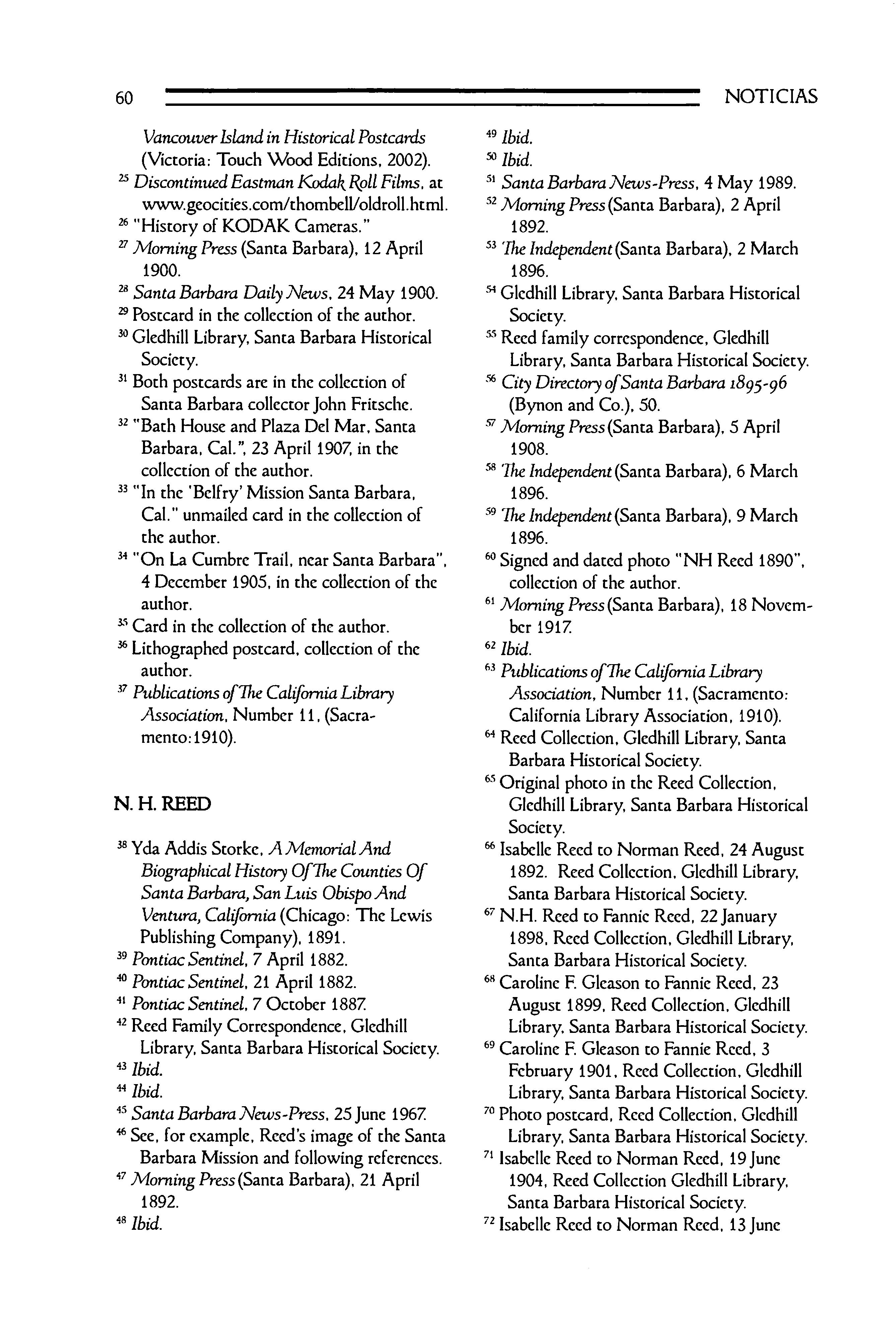
49 51 52 53 51 55 56 57 58
Ibid. ^Ibid.
SantaBarbaraNews-Press,4May 1989. AfomingPress(Santa Barbara).2April 1892.
'TheIndependent{Santa Barbara),2 March 1896.
Gledhill Library,Santa Barbara Historical Society.
Reed family correspondence,Gledhill Library.Santa Barbara Historical Society. City DirectoryofSantaBarbarai8gyg6 (Bynon and Co.),50. MorningPress(Santa Barbara),5April 1908.
TheIndependent{Santa Barbara).6 March 1896. 59 TheIndependent{Santa Barbara).9March 1896.
60 61 Ibid.
Signed and dated photo"NH Reed 1890”, collection of the author. AfomingPress(Santa Barbara), 18 Novem ber 1917
63 64 65 66 68 69 70 71
PublicationsofThe CaliforniaLibrary Association,Number 11,(Sacramento.California Library Association, 1910).
Reed Collection,Gledhill Library,Santa Barbara Historical Society. Original photo in the Reed Collection. Gledhill Library,Santa Barbara Historical Society.
Isabelle Reed to Norman Reed,24 August 1892. Reed Collection. Gledhill Library. Santa Barbara Historical Society. N.H.Reed to Fannie Reed,22January 1898,Reed Collection.Gledhill Library. Santa Barbara Historical Society. Caroline F.Gleason to Fannie Reed,23 August 1899,Reed Collection. Gledhill Library,Santa Barbara Historical Society. Caroline F. Gleason to Fannie Reed,3 February 1901,Reed Collection.Gledhill Library,Santa Barbara Historical Society.
Photo postcard,Reed Collection. Gledhill Library.Santa Barbara Historical Society. Isabelle Reed to Norman Reed. 19June 1904,Reed Collection Gledhill Library, Santa Barbara Historical Society. Isabelle Reed to Norman Reed,13June
NOTICIAS 60
25 26 27 28 32 33 34 36
1912,Reed Collection,Gledhill Library, Santa Barbara Historical Society. Isabelle Reed to Norman Reed,19July 1912,Gledhill Library,Santa Barbara Historical Society.
74 75 77 78 80
San Francisco EveningPost,Frank Harrison Gassaway writing as Derrick Dodd,a series of pieces, 1882. TheIndependent{Santa Barbara),6 April 1896.
Reed picture file 760.0. This photo appears with additional information in the Hastings(HLC)Scrapbook,page 66. Both at the Gledhill Library,Santa Barbara Historical Society. Both cards in the collection of the author. Ibid.
DailyNewsandIndependent(Santa Barbara), 19 November 1917 MorningPress{Santa Barbara),18 Novem ber 1917
W.W.HIGGINS
81
Mrs. Millie Higgins,interview with author, 28 October 2002.
David Blair,grandson of WW Higgins, interview with author. 11 October 2002.
Nonah Higgins,daughter of WW Higgins,from her memoirs of 1974 provided to the author by David Blair. AfomingPress(Santa Barbara), 11 Septem ber 1901.
Ibid.
Oliveand Qold,published by the Senior Class.Santa Barbara High School. May, 1912.
Nonah Higgins,daughter of WW Higgins,from her memoirs of 1974 provided by David Blair.
Oliveand Qold.published by the Senior Class.Santa Barbara High School, December 1911,59.
Mrs. Millie Higgins,from a card in her personal collection.
David Blair,grandson of WW Higgins, interview with author. 11 October 2002. Higgins interview, 28 October 2002.
Ibid.
Blair interview. 11 October 2002.
94
Higgins memoirs. Higgins interview, 28October 2002. 95
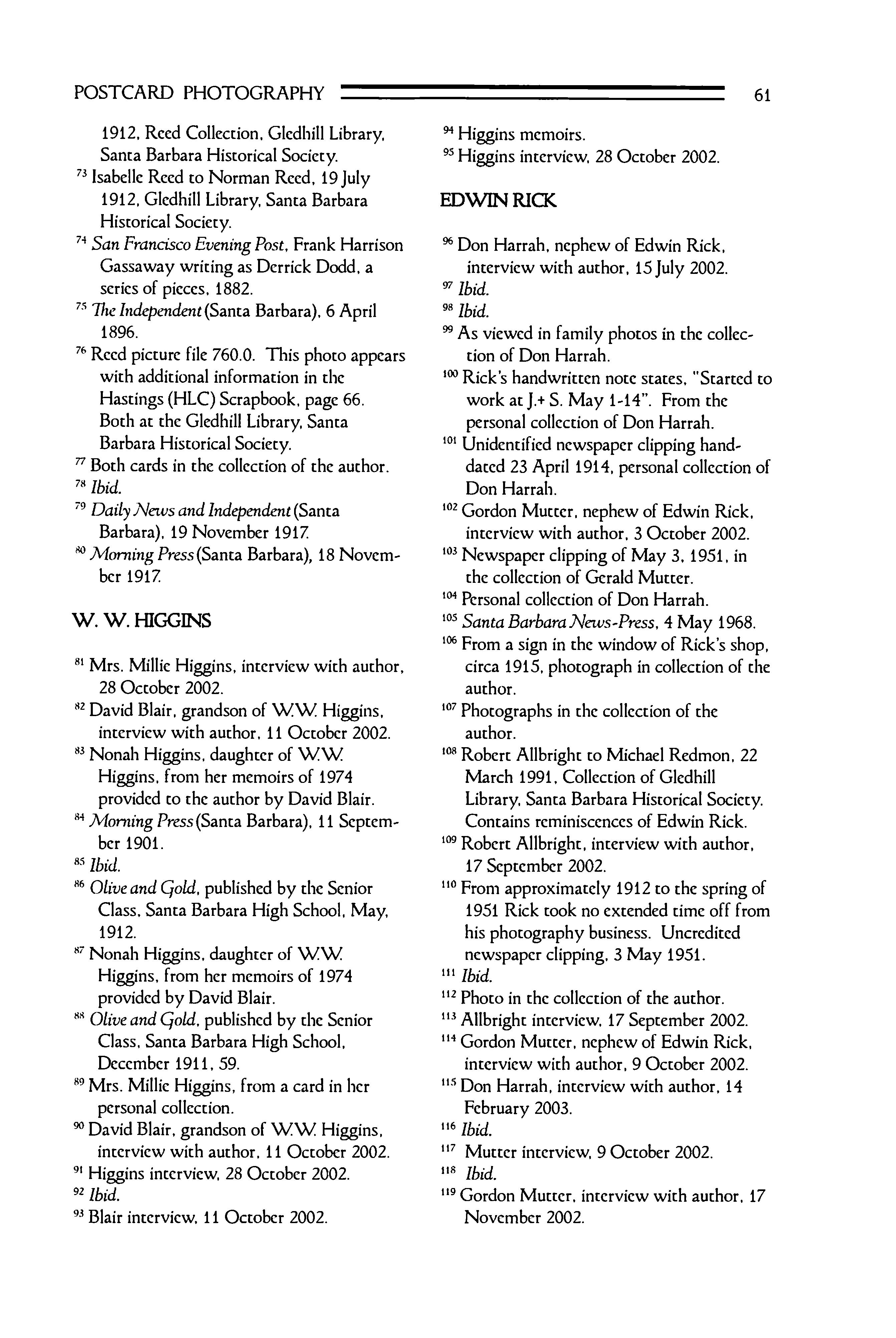
EDWIN RICK
96
Don Harrah,nephew of Edwin Rick, interview with author. 15July 2002. ^Ibid. Ibid.
99 100 101 102 103 105 107
As viewed in family photosin the collec tion of Don Harrah. Rick’s handwritten note states,"Started to work atJ.+ S. May 1-14”. From the personal collection of Don Harrah. Unidentified newspaper clipping handdated 23 April 1914,personal collection of Don Harrah.
Gordon Mutter,nephew of Edwin Rick, interview with author,3October 2002. Newspaper clipping of May 3. 1951,in the collection of Gerald Mutter. Personal collection of Don Harrah.
SantaBarbaraNews-Press,4May 1968. From a sign in the window of Rick’s shop, circa 1915,photograph in collection of the author.
Photographs in the collection of the author.
Robert Allbright to Michael Redmon,22 March 1991,Collection of Gledhill Library.Santa Barbara Historical Society. Contains reminiscences of Edwin Rick.
Robert Allbright.interview with author. 17September 2002.
From approximately 1912to the spring of 1951 Rick took no extended time offfrom his photography business. Uncredited newspaper clipping,3 May 1951. Ibid.
Photo in the collection of the author. Allbright interview. 17September 2002. Gordon Mutter,nephew of Edwin Rick, interview with author,9October 2002. Don Harrah,interview with author, 14
February 2003.
Mutter interview.9October 2002. Ibid.
Gordon Mutter,interview with author. 17 November 2002.
POSTCARD PHOTOGRAPHY 61
109 110 111 113 114 115
84 85 86 88
90 116 Ibid. 117
91 118 119
Harrah interview. 14February 2003. 121 Ibid.
Harrah interview,14 February 2003. Allbright to Redmon,22March 1991. Robert Allbright.interview with author. 17 November 2002.
Series of photographs in the collection of the author.
William Lennon,interview with author.
26 September 2002.
Ibid. 127
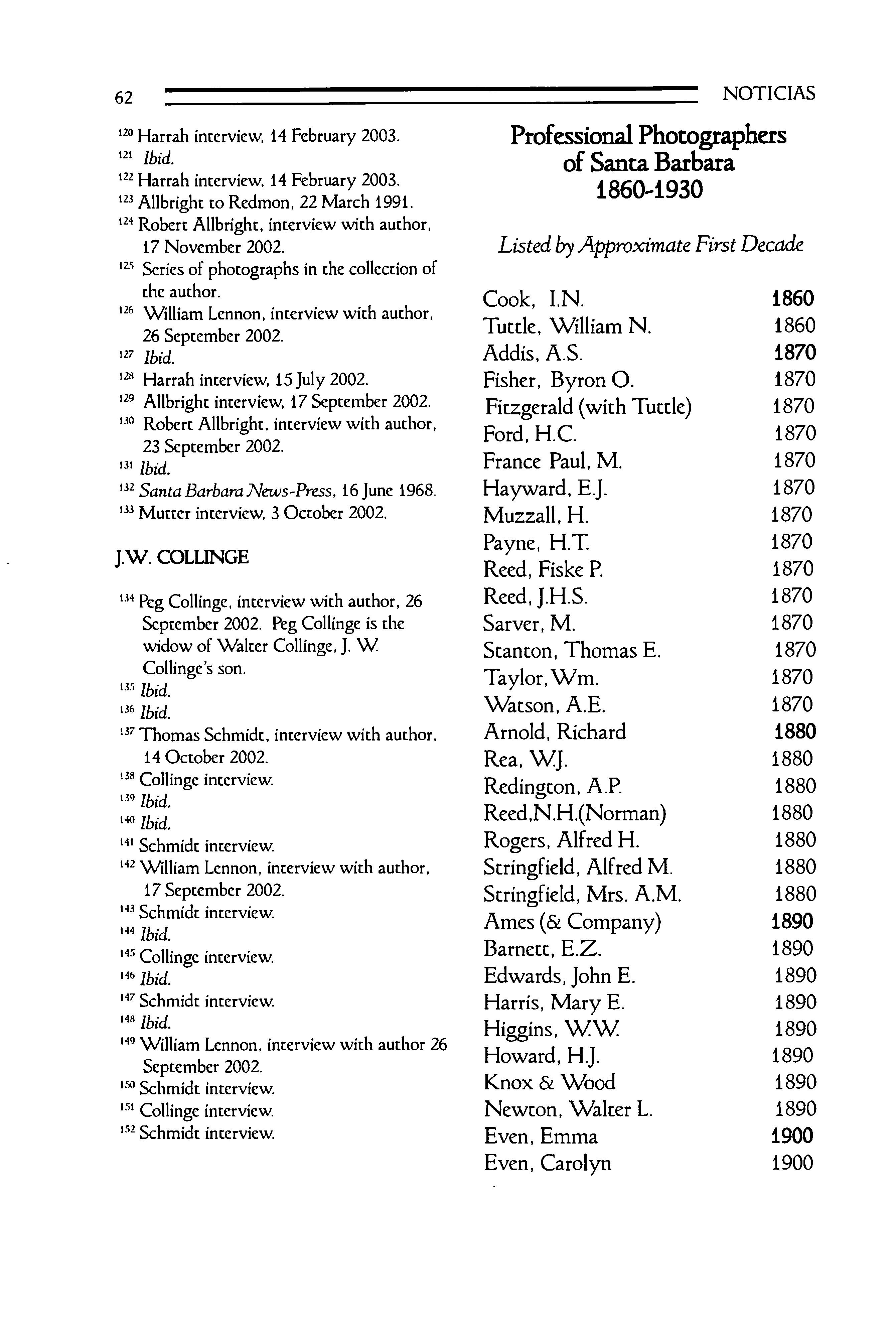
Harrah interview,15July 2002. Allbright interview. 17September 2002. Robert Allbright.interview with author. 23September 2002. Ibid.
SantaBarbaraNews-Press,16June 1968. Mutter interview,3October 2002.
J.W. COLLINGE
1.54
Peg Collinge,interview with author,26 September 2002. Peg Collinge is the widow of Walter Collinge,J. W Collinge’s son. Ibid. Ibid.
ThomasSchmidt,interview with author. 14 October 2002. Collinge interview. Ibid. Ibid. Schmidt interview. William Lennon,interview with author, 17September 2002. Schmidt interview. Ibid.
Collinge interview. Ibid. Schmidt interview. Ibid. H9 William Lennon,interview with author 26 September 2002. Schmidt interview.
1.52
Professional Photographers of Santa Barbara 1860^1930
Listed by Approximate First Decade
Cook, I.N. Tuttle, William N. Addis, A.S. Fisher, Byron O. Fitzgerald(with Tuttle) Ford, H.C. France Paul, M. Hayward, E.J. Muzzall. H. Payne, H.T Reed, Fiske P Reed,J.H.S. Sarver, M. Stanton, Thomas E. Taylor,Wm. Watson, A.E. Arnold, Richard Rea, WJ. Redington, A.P Reed,N.H.(Norman) Rogers, Alfred H. Stringfield, Alfred M. Stringfield, Mrs. A.M. Ames(& Company) Barnett, E.Z. Edwards,John E. Harris, Mary E. Higgins. WW Howard, HJ. Knox & Wood Newton, Walter L. Even, Emma Even, Carolyn
1860
~ NOTICIAS
62
122 123 124
m
1860
1870
1870
128 129 1870 130 1870 1870 1870 132 1870 1870
1870 1870
138 139 140 141 143 144 146 151
Collinge interview. Schmidt interview. 1870 1870 1870 1870 1880 1880 1880 1880 1880 1880 1880 1890 1890 1890 1890 1890 1890 1890 1890 1900 1900
Paulding, Mervin Hartsook,J. Frederick Leach, Edin Lemoigne, Stanislas McLean, G.T Mills, G.S. Porteous, Edward Rainey, Edw. Rogers, A.S. Rogers, Frederick H. Sturtevant, Arthur Tollman Photo Alsup Clark,Winfield Collinge,J.W Collins,J.R. De Gaston, Percy Decker, Hiram Paulding,Dwight D Gledhill, WE. Gledhill, Carolyn Hay, Miss A. Hoffman, Charles A. Leach, Elvira Lee, Benjamin Martin S.V, Myers,T.A. Wagner,Jessie Reed, Abbe Rick, Edwin Zane, Otis W Bartels, Carl Beals, Jessie T. Brown, Charles H. Burkhart,J.C. Buttermere, N.L. Paulding, Dwight Greene,PH. Hopkins, La Verne
1900 1920 1920 1900 1900 1920 1920 1900 1920 1900 1900 1920 1920 1900 1920 1900 1920 1900 1930 1900 1930 1900 1900 11 1910
1910 1910 1910 1910 1910
1910 1910 1910 1910 1910 1910 1910 1910 1910 1910 1910 1910 1910 1920 1920 1920 1920 1920 1920 1920 1920
Jensen, A.M. Jezler, C.L. Kaiser, Art McAllister, H.E. Meese,TW Nygreen, Peter Obert, Karl Stigleman, Geo Vbn Rohan, Arthur Anderson, Fred G Bordeux, Robert Sacket, E. Ackley
Sources: city directories, newspapers, vari ous publications, photographer directories published by Peter E.Palmquist,and the files of the Santa Barbara Historical Society.
A professional photographer is one who ad vertises and solicits photography business, or establishes a studio for commercial use,or for whom evidence exists corroborating the sale or publication of photographs.
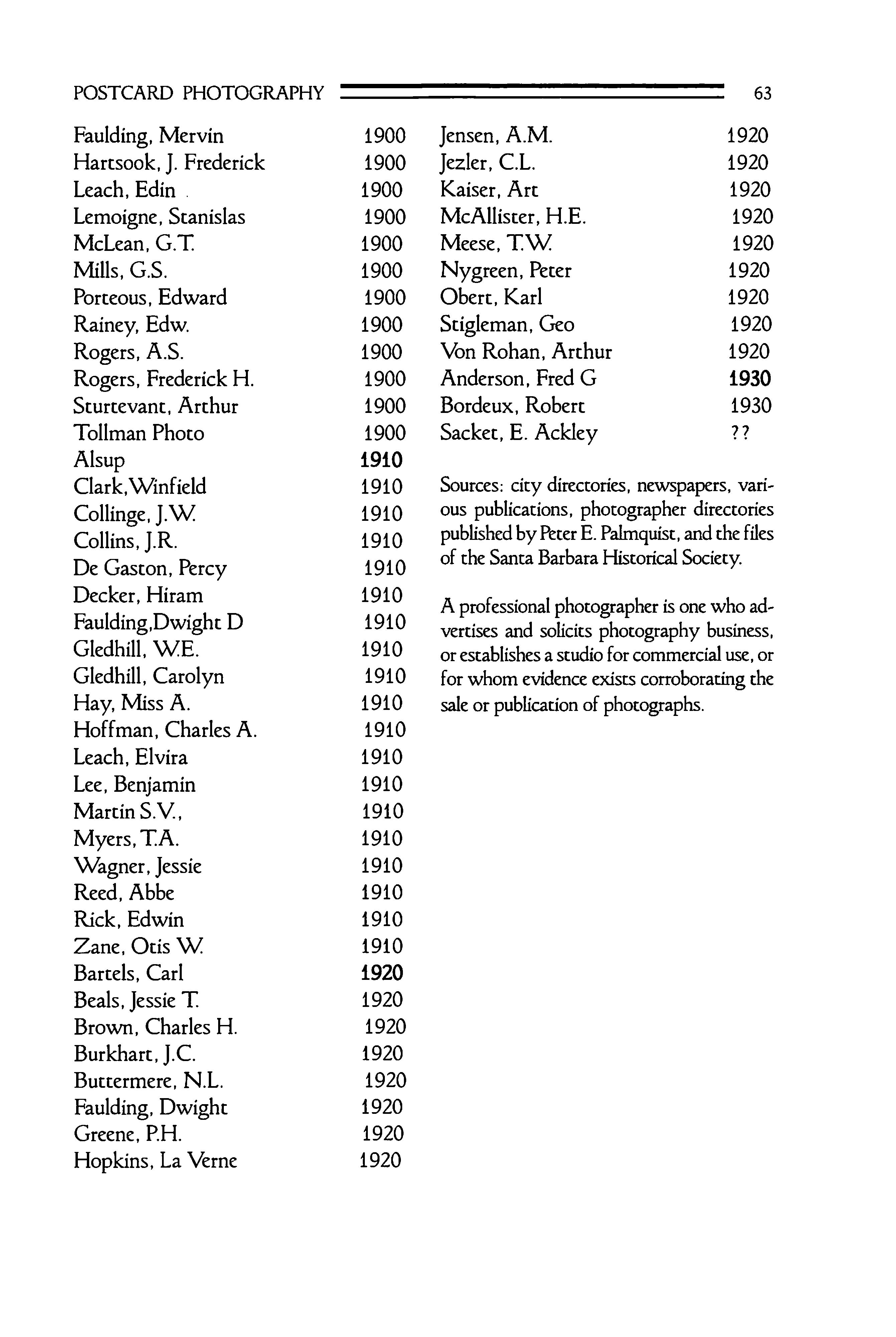
POSTCARD PHOTOGRAPHY 63
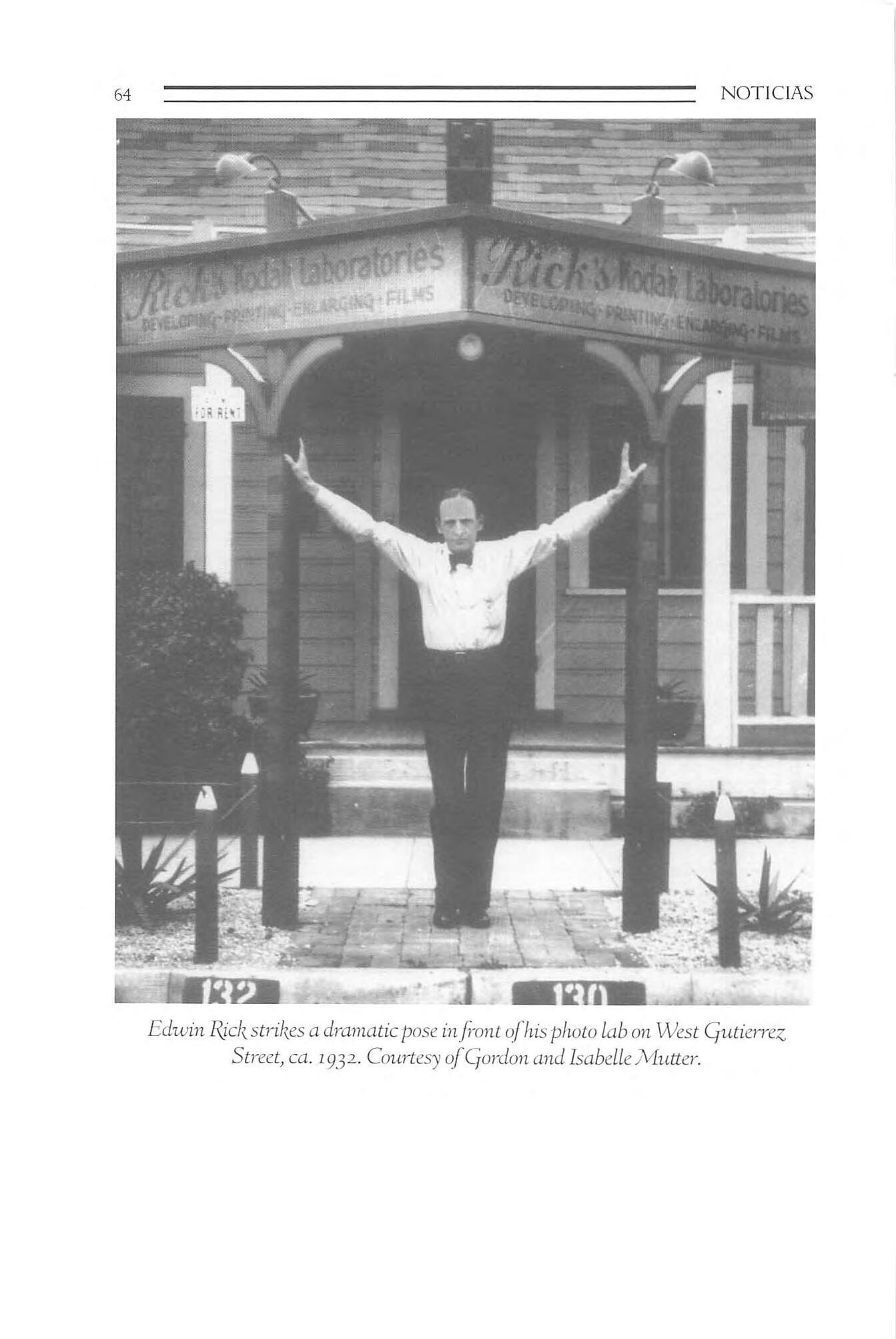
3]pqvsj puv Jouopiofp) ,is?j.inop) -z£6i -vd 2?MOjpif^ ?S2t/y\ 7^’/ ojcnjd jofntj mjuo.if onviump?so<^ v s;?'ijhijs uinipj SVI3IXON

